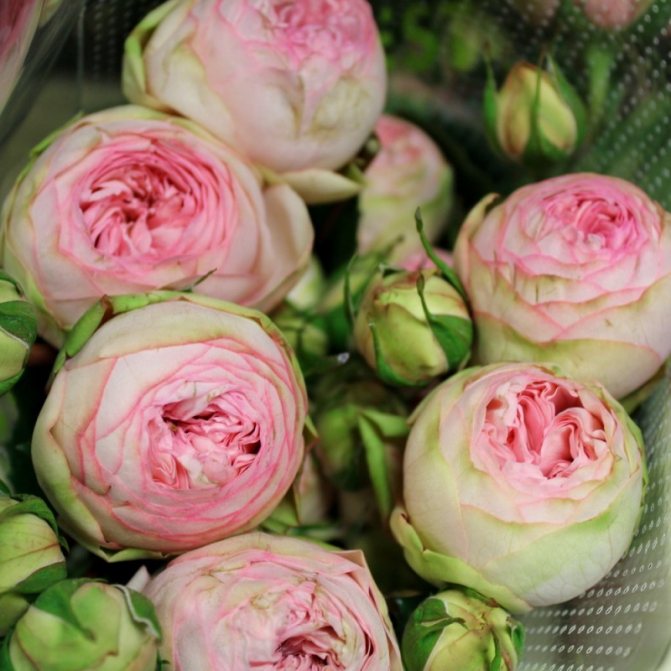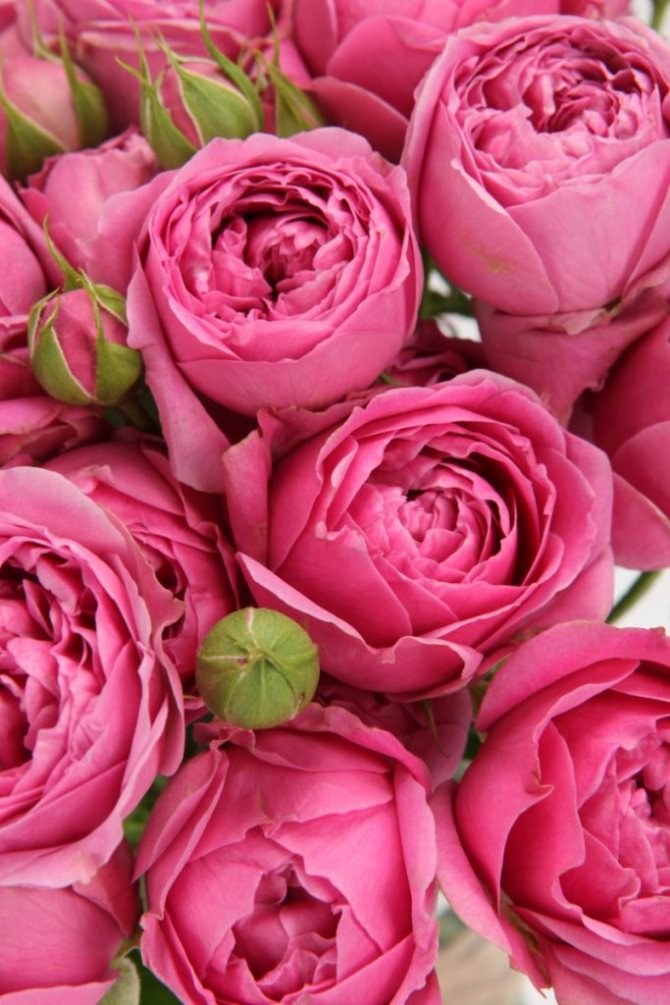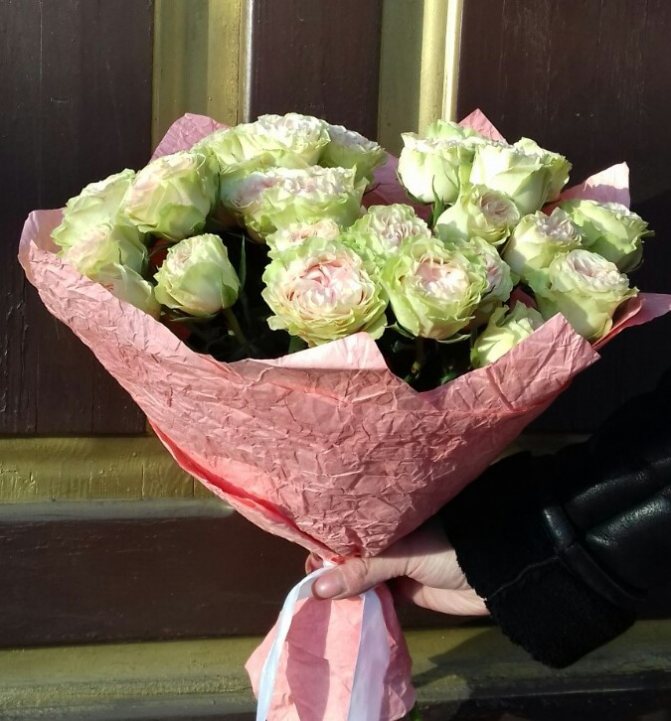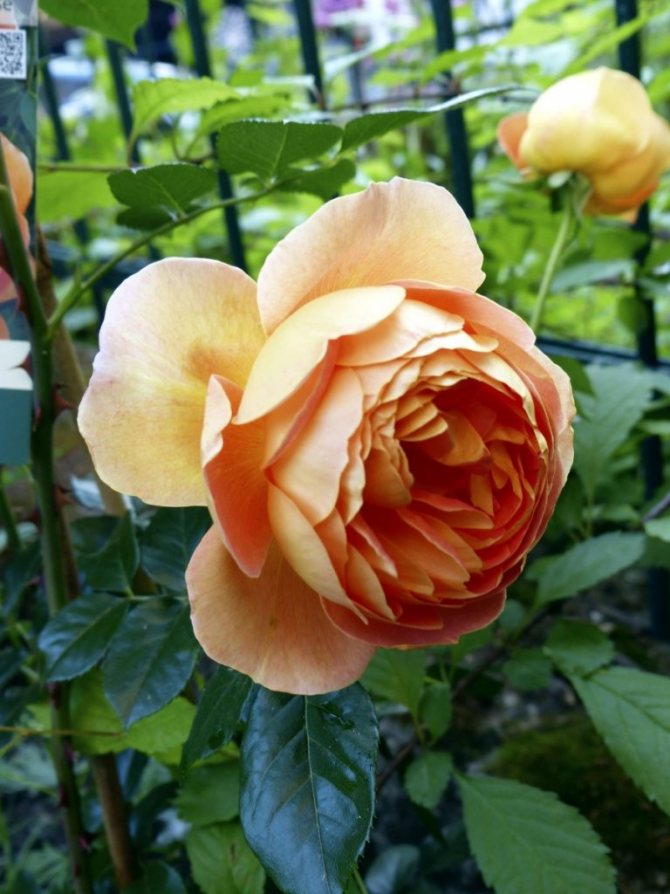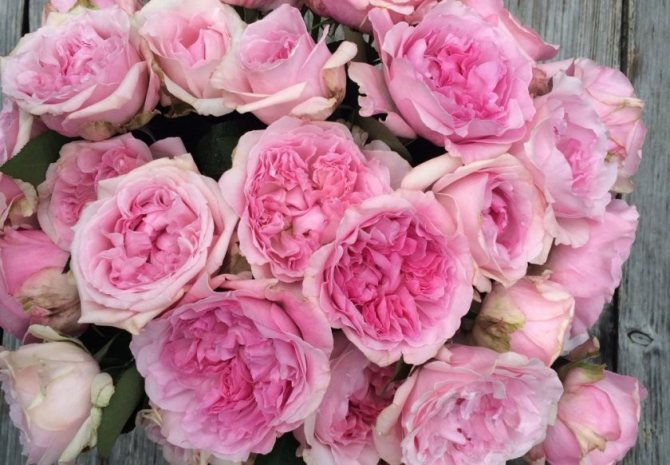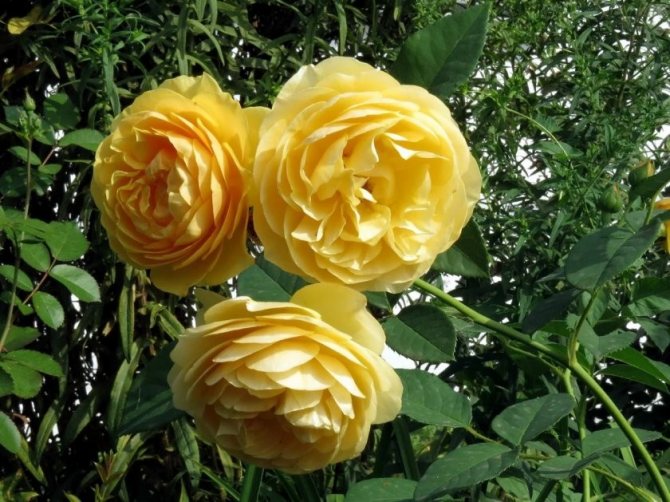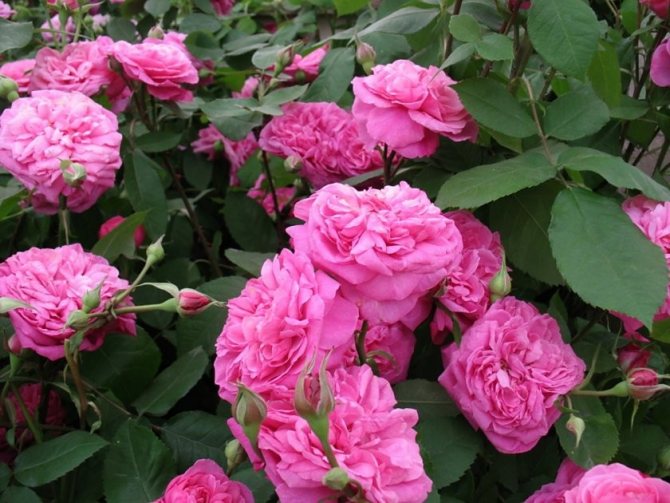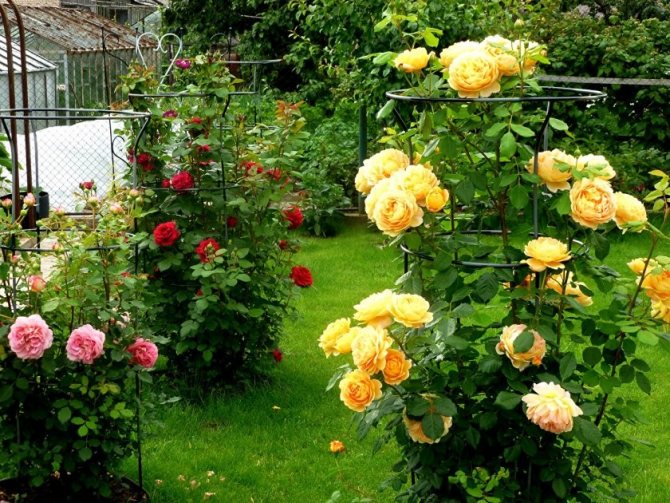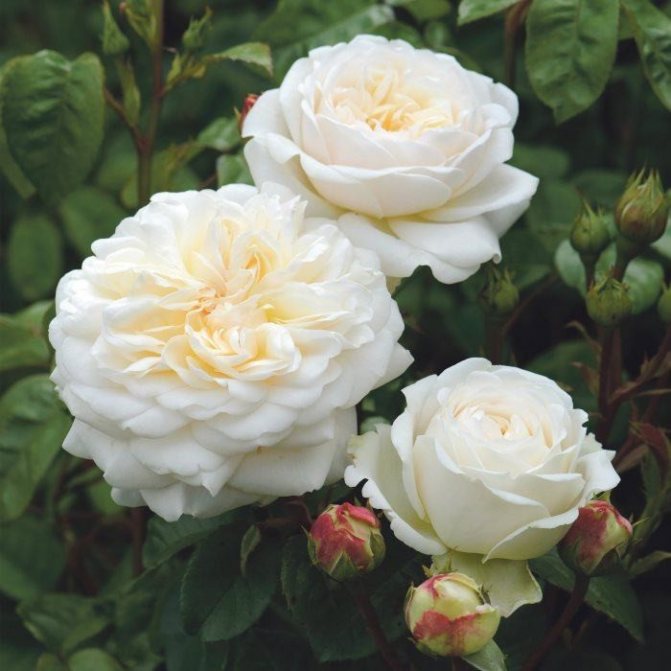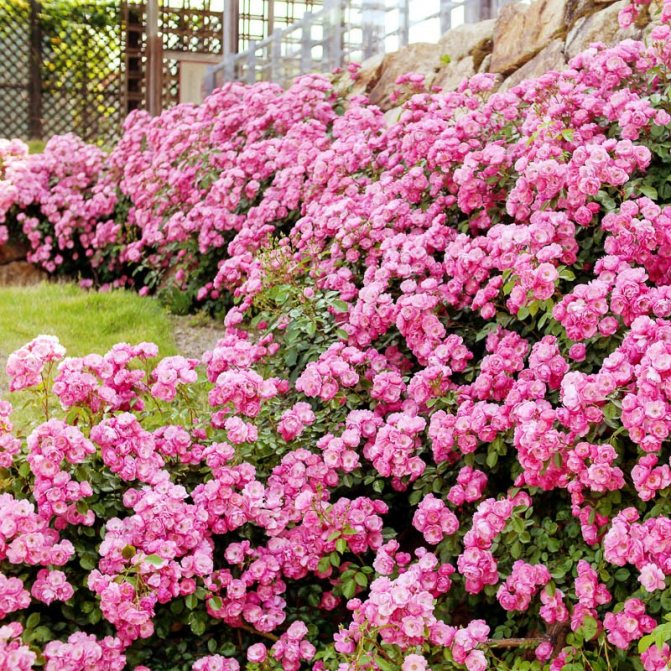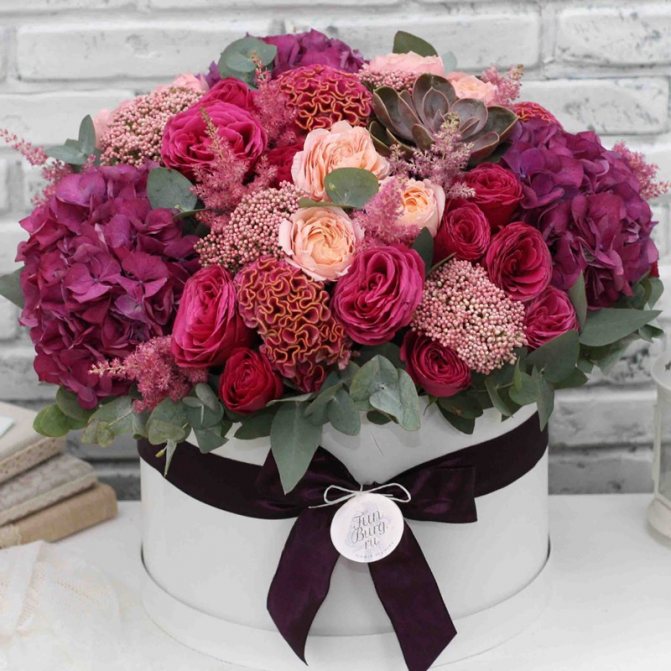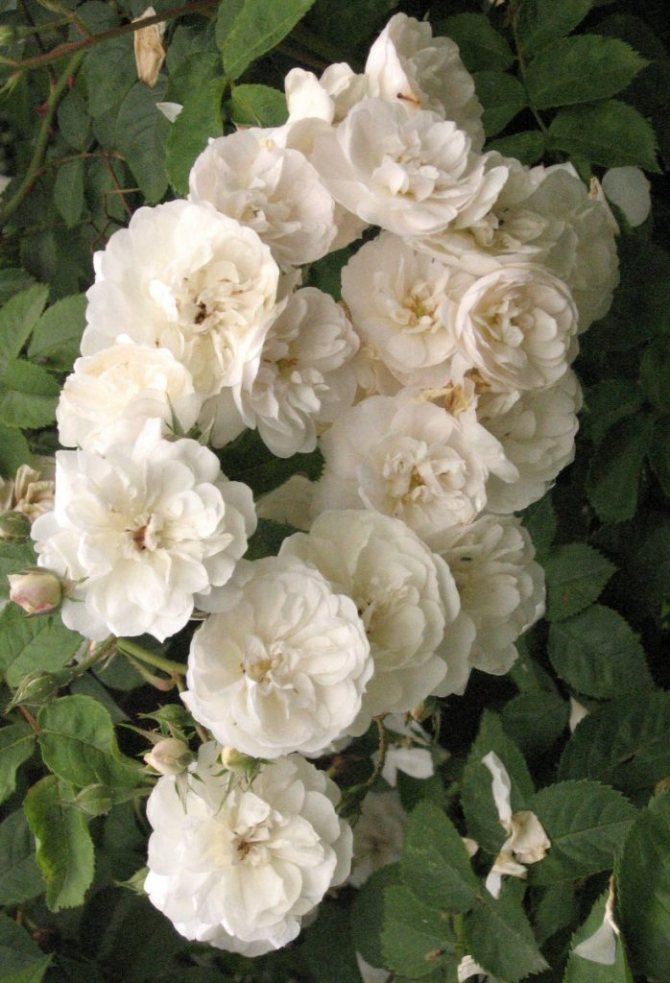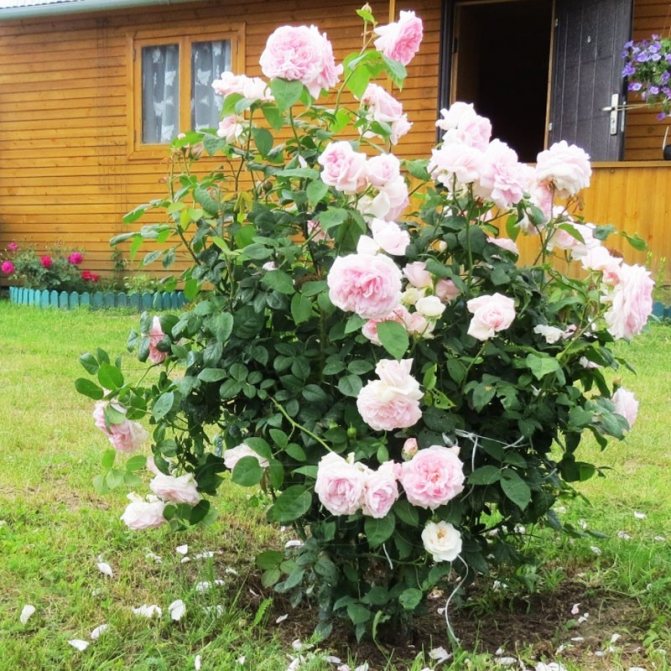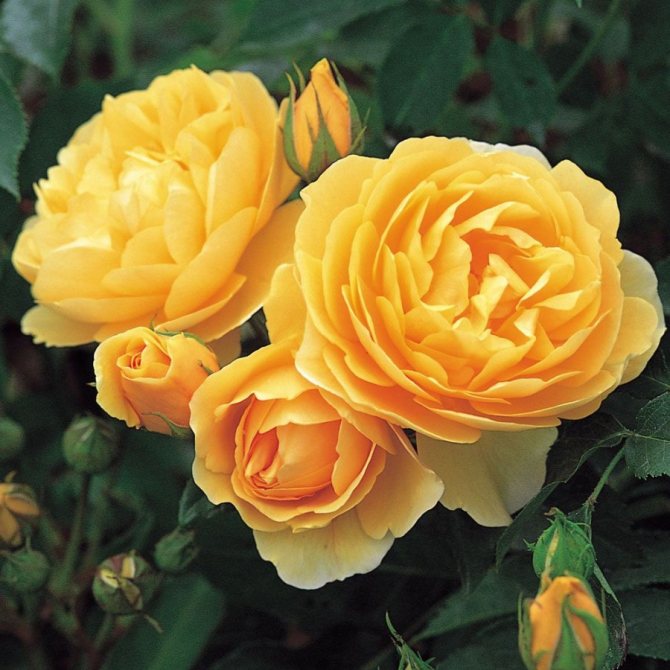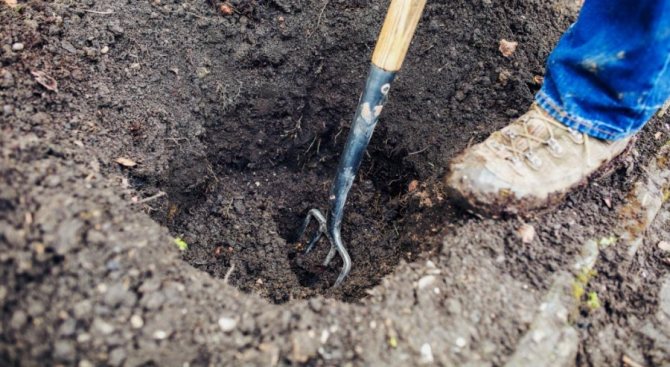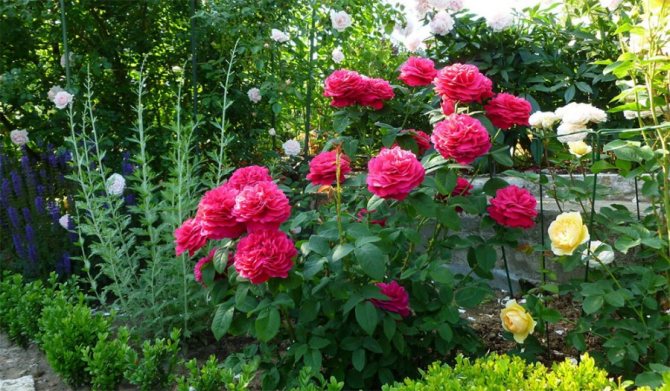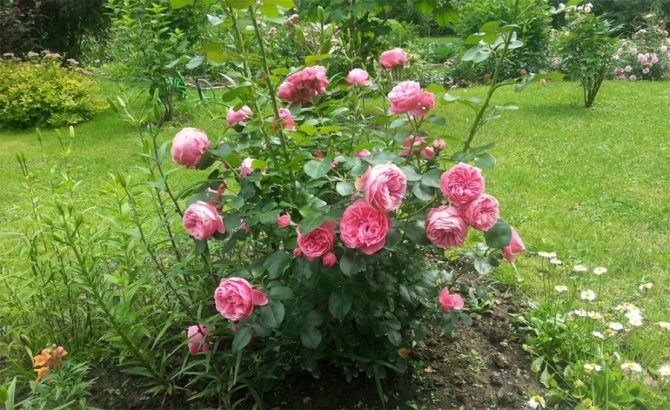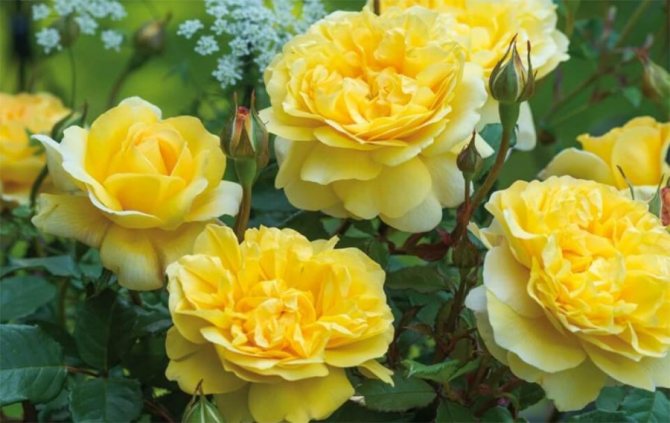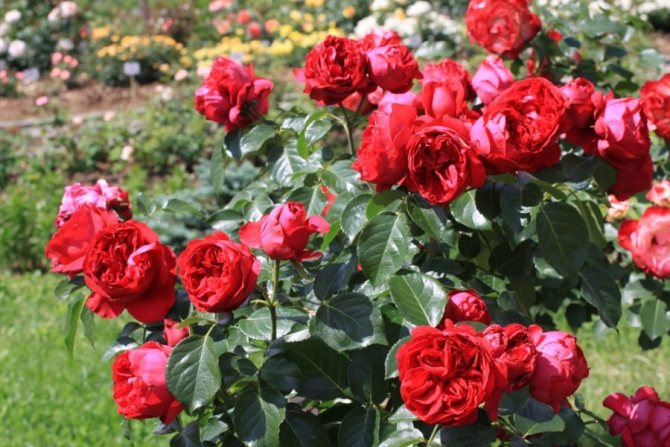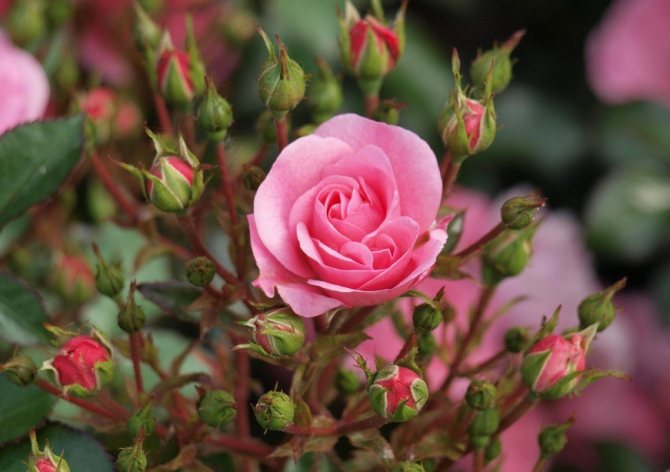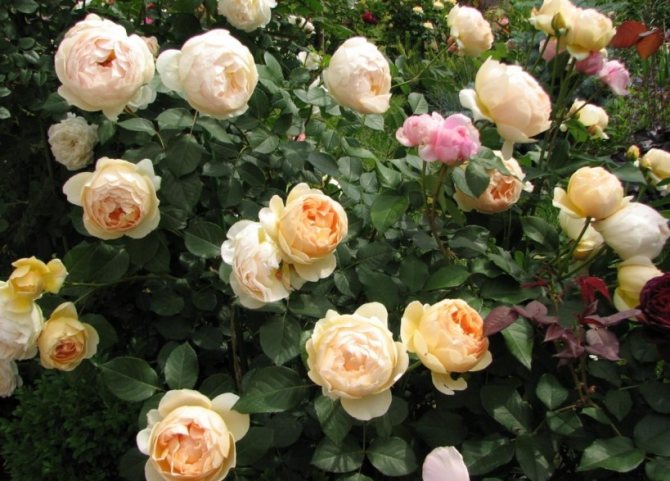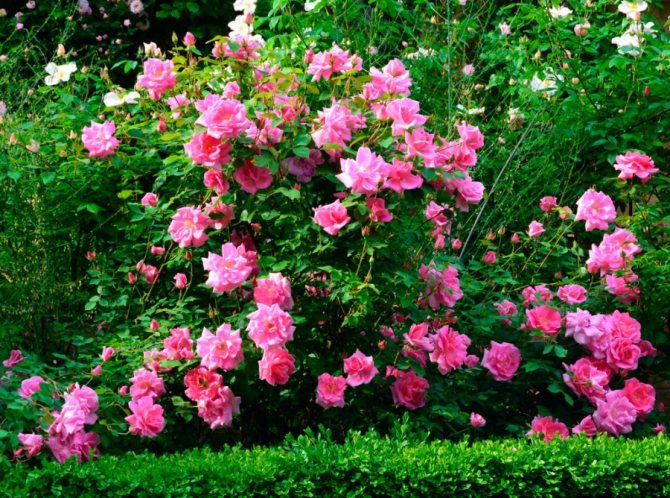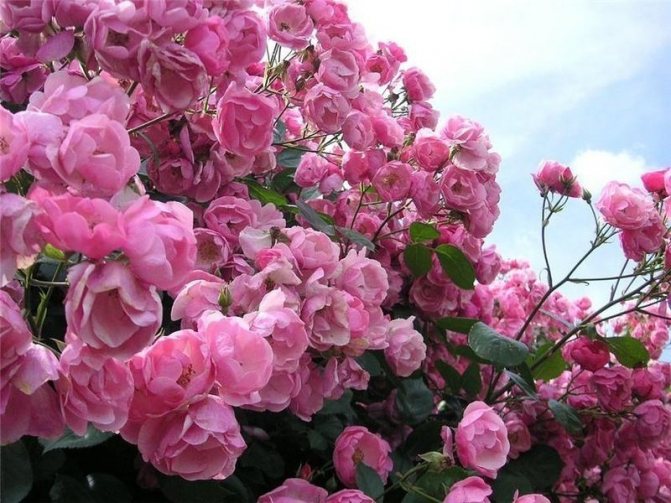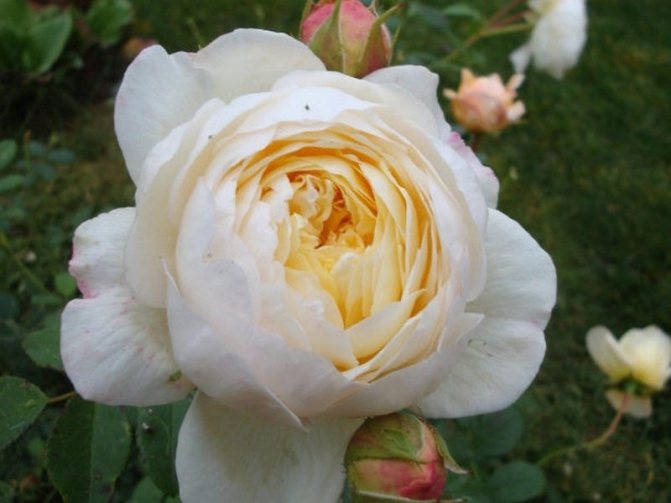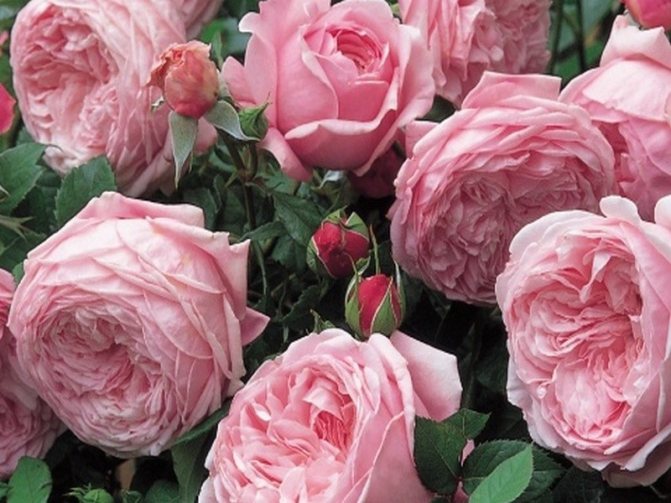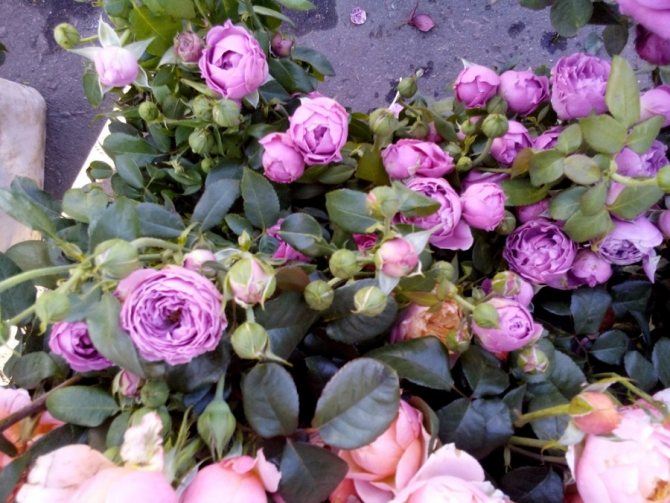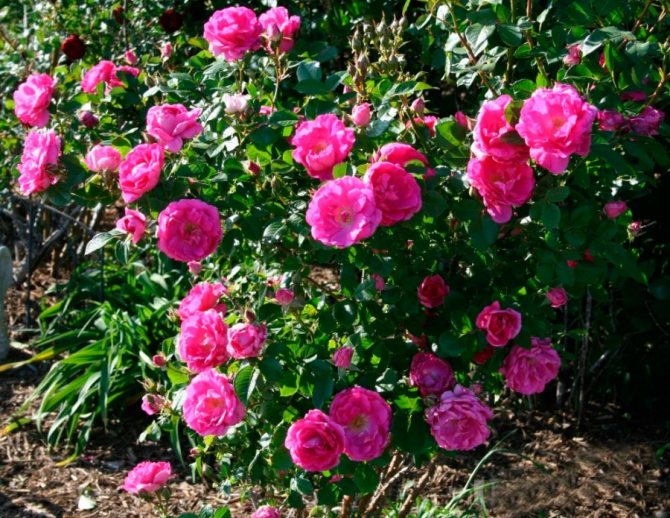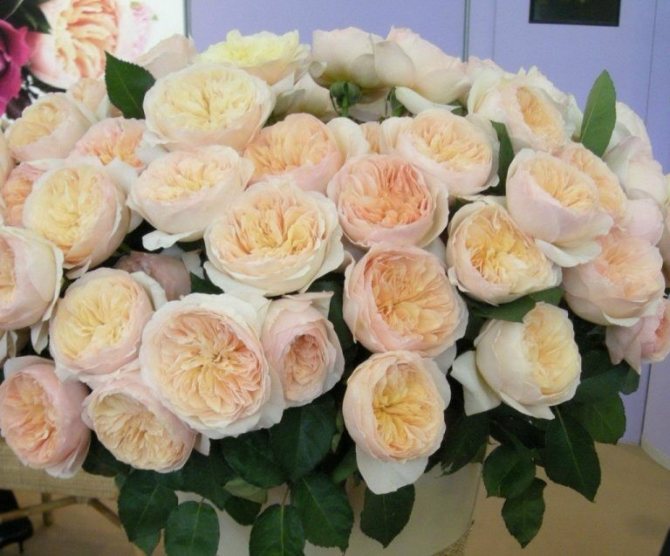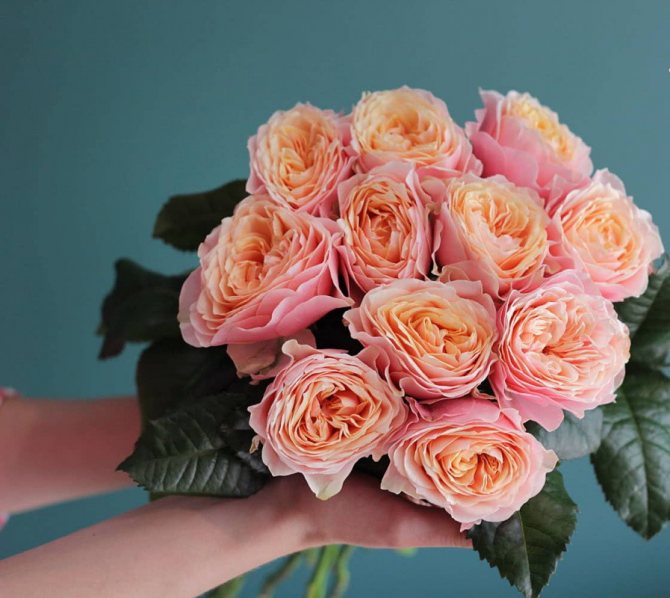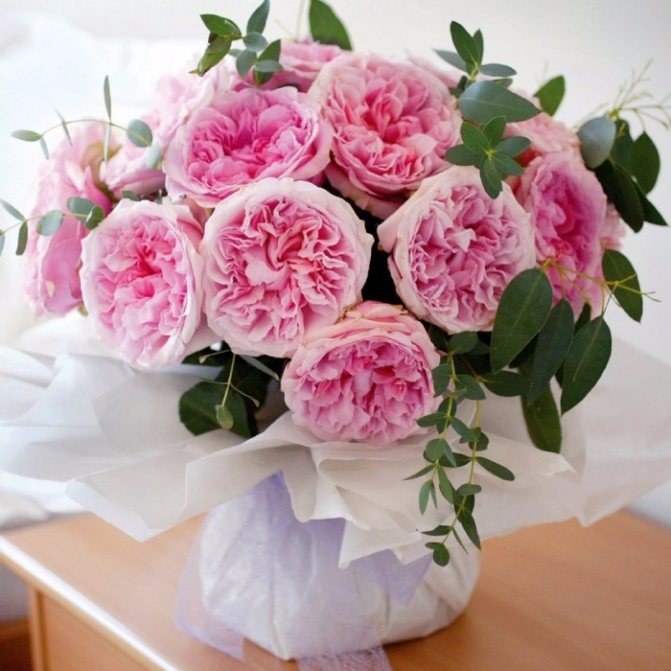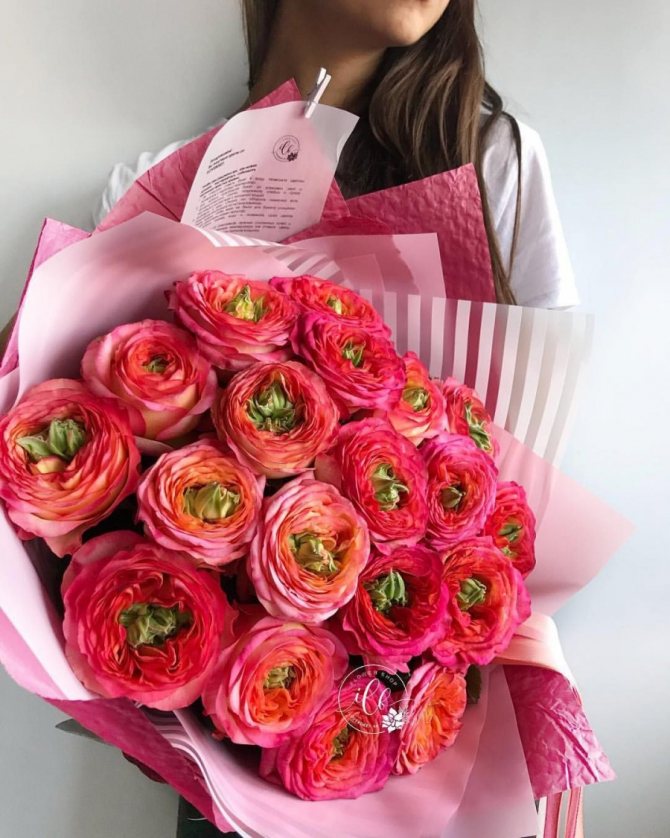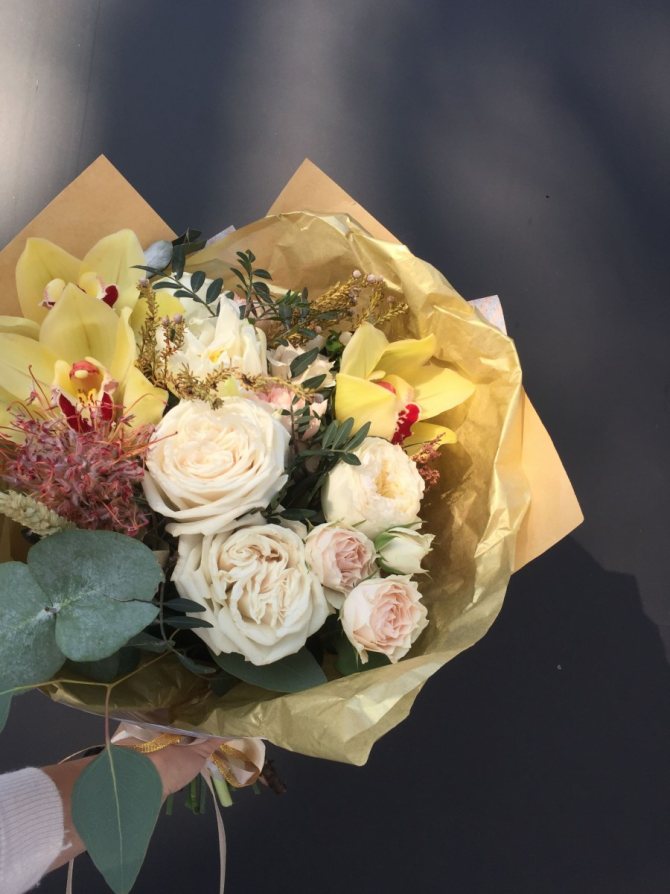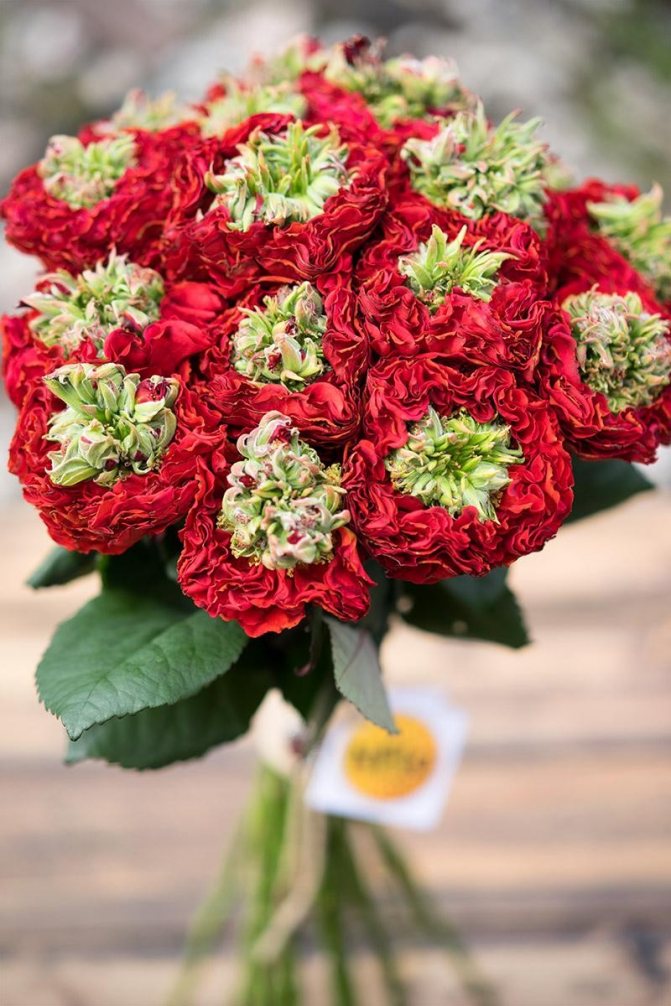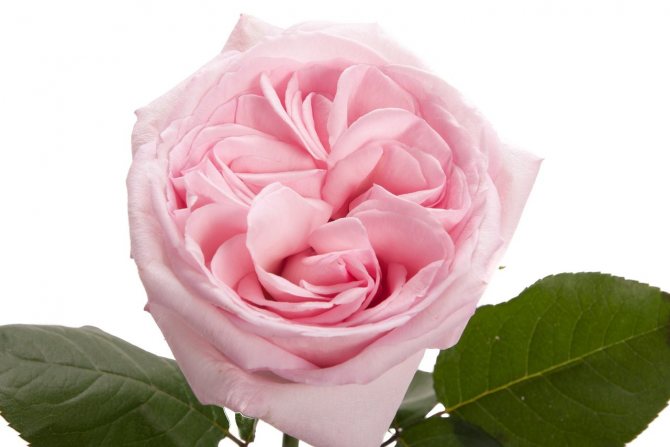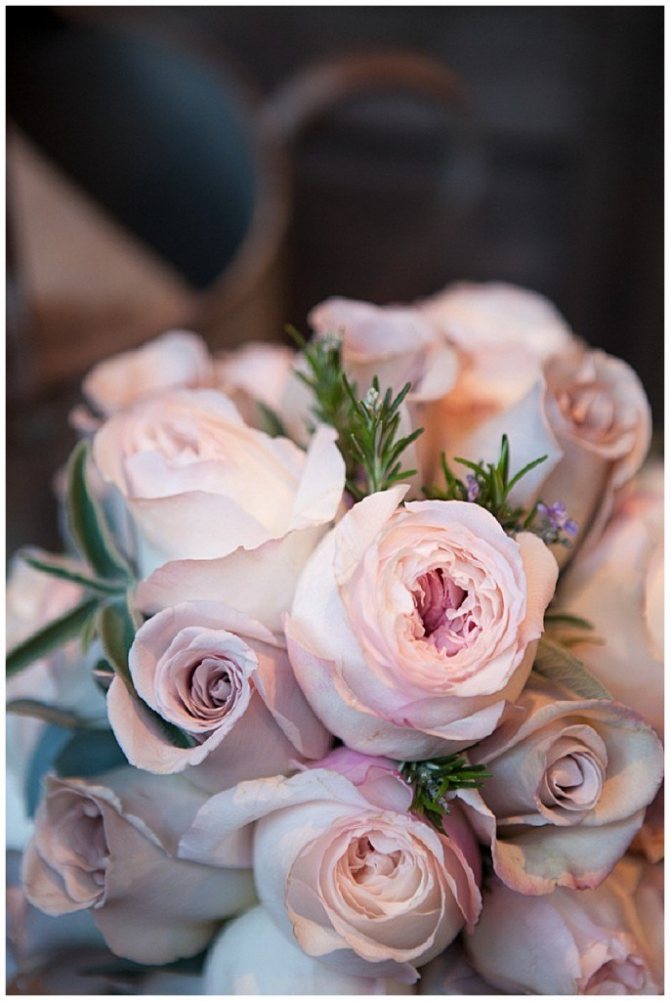Peony roses are famous for their high aesthetic qualities, unpretentiousness, endurance. These plants are hybrids bred by David Austin - an outstanding breeder, scientist from England. Today, many varieties of these magnificent flowers grow on flower beds, the petals of which amaze with original shades, tonal transitions. Within the framework of this article, information is provided with a photo about the most popular peony varieties. Its study will enable each grower to draw conclusions about the advisability of growing the species of interest, learn about their advantages and disadvantages.
An excursion into history
British botanist David Austin perfected the English rose garden queen flora. The reason for the idea was factors that clearly did not satisfy the young plant breeder - a rather limited blooming time, susceptibility to infections.
The aim was to create perfect varieties of a new kind, combining the classics with a hybrid tea variety.
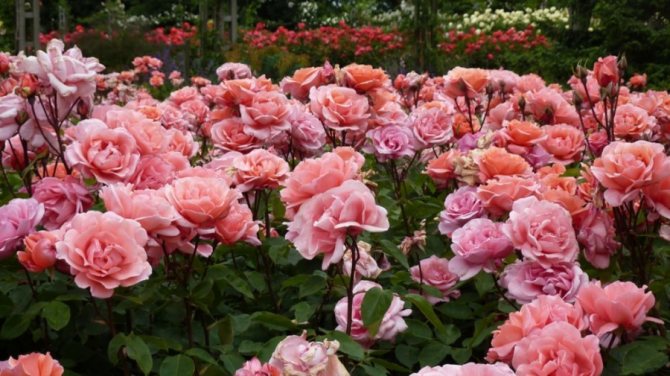
The task at hand demanded hard work and careful research. As a result of long-term development, humanity has acquired several improved samples of what was conceived.
The seventies of the last century were marked by success, the scientist's dream came true.
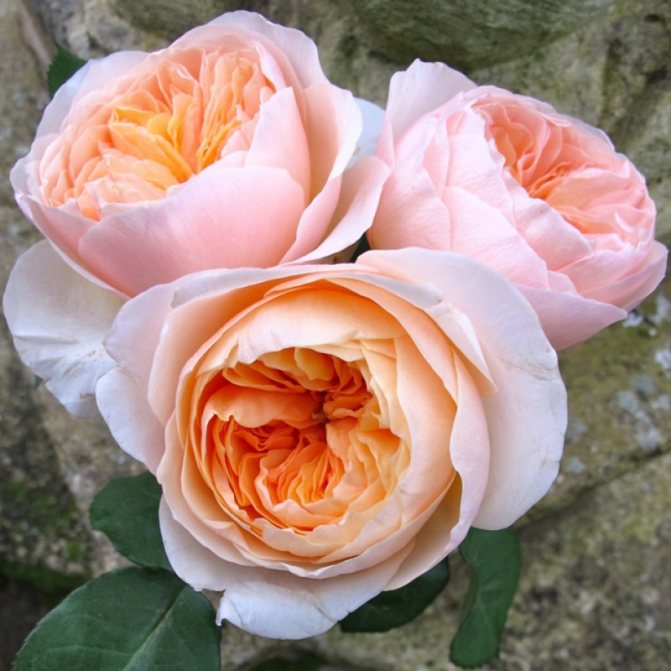

Floriculture has acquired an excellent bush, pleasing to the eye with the splendor of inflorescences, austenka resistant to diseases and pests.
Overview of yellow varieties
Scientists have created many varieties of plants that are impressive in the luxury of yellow shades. For the climatic conditions of our country, the specimens listed below are best suited.
- Graham Thomas. The variety was introduced to the public in 1983. The Graham Tomas buds have a bright yellow color with spectacular peach tints. Flowering occurs throughout the season (summer - autumn). On the stems there are 3 - 5 buds with a sweet smell. Graham Thomas reacts steadily to bad weather and illness.
- Golden Celebration. The peony rose is approved by flower growers because of the lush buds blooming on the bush with a maximum diameter of 16 cm. Each inflorescence contains 3 - 5 flowers with a strong, pleasant fragrance. The color of the petals is honey-yellow. On a one and a half meter bush, arched stems grow, covered with thorns in large numbers. Golden Celebration is not afraid of bad weather, rarely gets sick, blooms all summer.
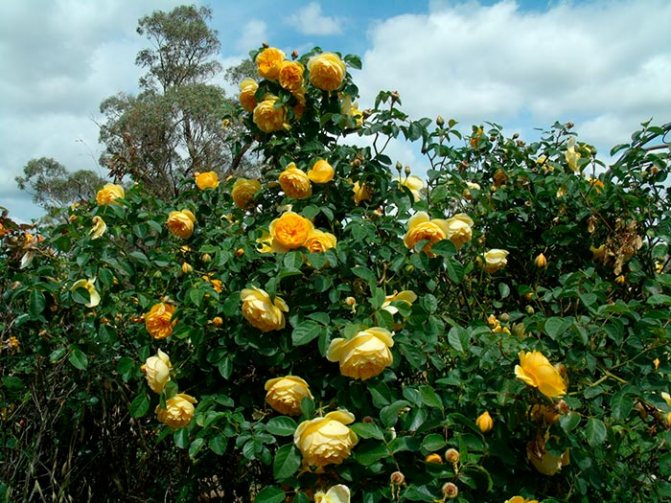

Golden Celebration
- Toulouse Latrec. It is a low shrub (90 - 120 cm in height). Toulouse-Lautrec flowers have a rich yellow color with a characteristic fading at the edges. Due to the long shoots, florists use cut pieces with single corollas in bouquets.
Distinctive properties
The main characteristic of the breeding novelty is good resistance of pathogenic microbes, endurance. The peculiarity of growth (the absence of wild growth) attracts flower garden lovers.
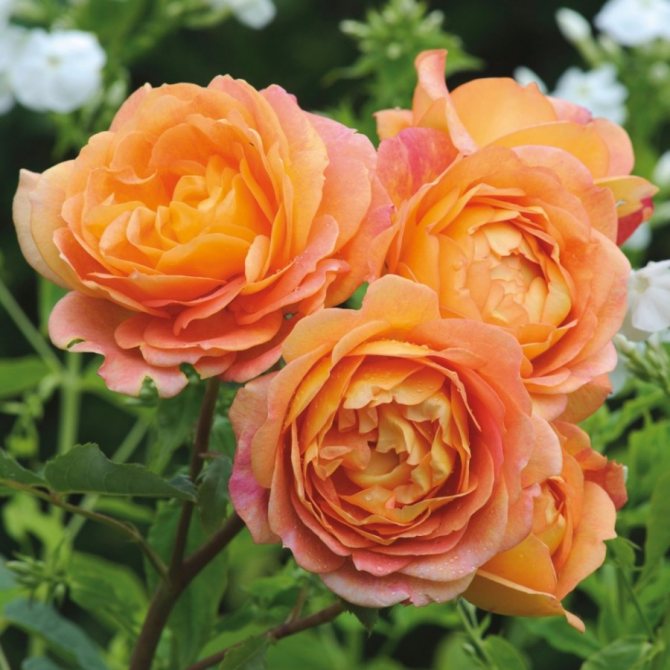

Maintenance requirements are minimal, the result is an excellent decoration of the backyard area. Signs of achievement of an outstanding breeder conquer hearts - large amazing buds, aromas of the finest notes, distinguished by persistence.
Certain types for the entire period are in a semi-open position, remaining in their original appearance. Others, on the contrary, bloom twice.They stand out for their extremely early opening of the ovaries.
Attention! Novice summer residents are advised to work with varieties that have an abundant number of colors. Simpler procedure, less problems with cutting, forming the desired configuration.
A verbal description of the beauty of rose trees is not able to convey reality. Today, the opportunity to visually get acquainted with an overview of the best varieties is provided by numerous sites of florists, florists, landscape creators.
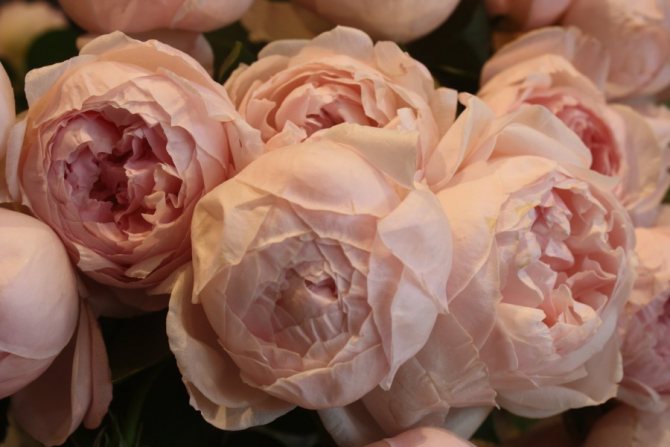

Sarah Bernhardt
Pink peony. One of the most common varieties of peonies. They prefer it because of its unpretentiousness and sophisticated beauty. Sarah Bernhardt's semi-double peony bud consists of many petals tightly adjacent to each other. The color of this variety of peonies is from pearl pink to pale lilac. Sarah Bernhardt's peony buds are among the most lush. Bud size varies throughout the year. The largest peonies can be bought in April-May.
Peonies will delight you longer if, when purchasing, you give preference to still unopened and barely colored buds.
Base selection
The acquisition of planting material is an important step in the responsible cultivation cycle of an ostinka. It is recommended to buy a seedling in specialized stores, nurseries, from people who are trustworthy.
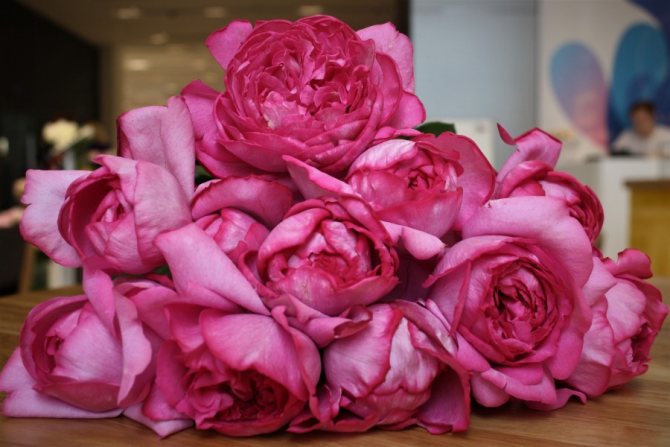

There is an open root system, closed rhizomes.
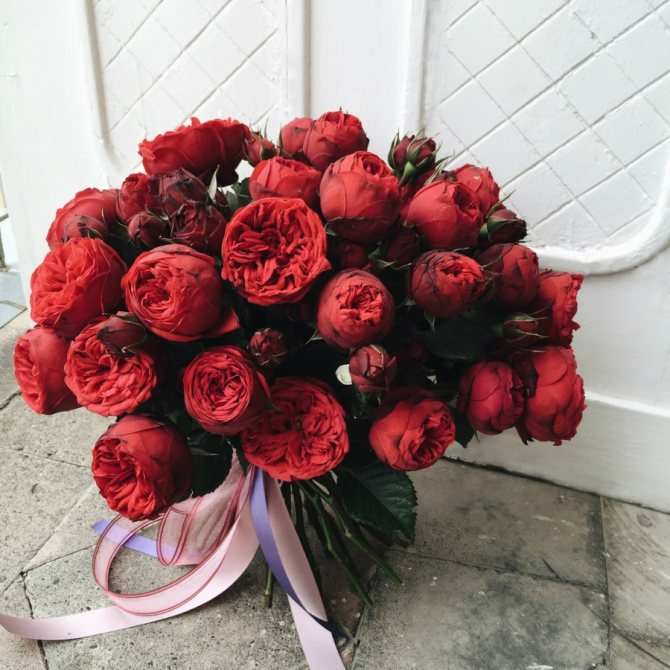

The first type can be acquired in spring, autumn. Visual inspection - the neck of the root should not exceed the 10 cm mark, the stems are not damaged, traces of fungal infection. Packaging - humid environment.
The second option is more reliable - protection with an earthen lump, which protects against injury, drying out. The sprout, shrouded in earth, is planted in a permanent place.
Often, amateur gardeners purchase ready-made samples in boxes - a good alternative to the two previous methods. Instant assessment of the appearance of the product, shades of petals, shape of buds, exquisite smell.
The disadvantage is high prices. It should be noted the main criteria for the high quality of seedlings:
- lack of green shoots;
- the kidneys are asleep;
- lack of faults;
- strong tender stem bark.
The next stage is the direct placement of the sprouts.
Flowers with pink petals
The pink color makes the lush flower even more delicate. Roses of different varieties are characterized by different shades, size of buds, degree of density, double petals.
- Miranda. The cultivation of the rose dates back to 2005. The flower has a combination of bright and pastel colors. The color of the outer petals is very delicate, and the inner ones are rich. The lush corolla has a maximum diameter of 12 cm. The stems are crowned with single flowers. The peculiarity of the variety is the absence of a pronounced aroma in Miranda.
- Rosalind. It resembles a peony. The bush is covered with single cream flowers, the size of which is 12 - 14 cm in diameter. Pozalinda pleases with a delicate, pleasant scent.
Varieties of peony roses
- Constance Spry. The history of the rose begins in 1961. It is the result of the painstaking work of a British breeder. Climbing bush, high (3 m in circumference, 6 m high), spreading. It is covered with large (diameter 14 cm) terry buds with a bright aroma, which do not open completely. Cultivation with support arrangement is recommended.
Advice! Constance Spry is desirable to provide a partial shade area.
Correct placement
The classical scheme recommends seating the beauties in a triangle, preferably of different names, placing them in the corners, keeping the distance between the prepared pits 50 cm.The recommended technique will occupy a small area in the garden.
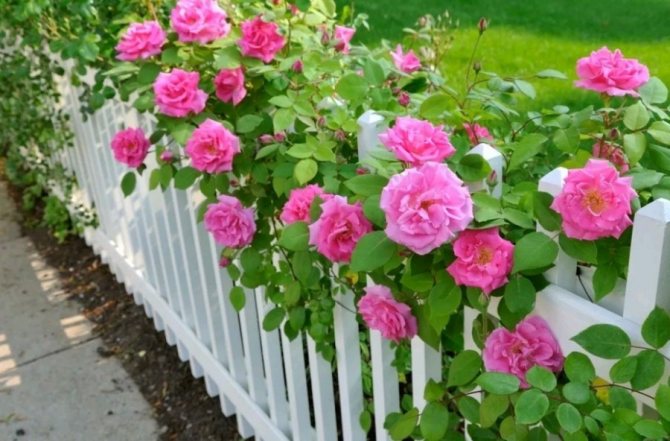

The beauty of the rose garden will be given by rose trees, which are in harmony with the color palette of all kinds of directions - monochrome, two-tone, variegated.
Competent cultivation involves:
- holes measuring 1 m wide, 0.5 m deep;
- bottom covered with compost;
- laying 15 cm;
- the possibility of shaded plots, acceptable sunlight - at least four hours;
- planting roots treated with a growth stimulator into the soil.
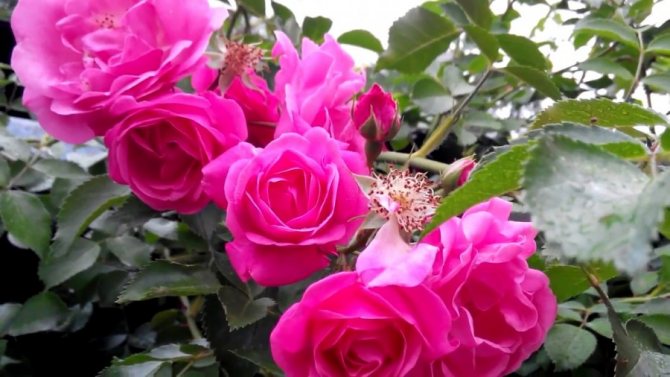

The result is obvious, you get a beautiful fragrant flower garden.
Adhering to an elementary complex, planting and caring for plants will not take much time.
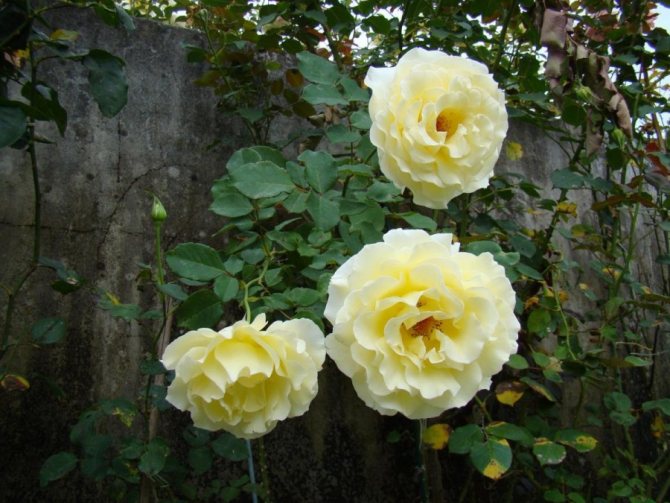

The luxury of red buds
Scarlet, crimson peony roses symbolize love, passion, impress with a richness of colors. They not only decorate flower beds, greenhouses, but are also used to create numerous floral masterpieces.
- Shakespeare. It differs from other varieties in its strongest aroma. The color (red, purple) is influenced by the growing conditions. A large number of buds (3-5 per inflorescence) bloom on a massive bush (reaches a height of 2 m). The diameter of the corolla of roses is maximum 8 cm. William Shakespeare demonstrates increased resistance to bad weather and diseases.
- Munstead Wood. A rose with medium-sized buds makes it possible to enjoy a magnificent fragrance during flowering. Blooming buds take on a dark color. The heart of Munstead Wood is covered with yellow stamens.
Munstead Wood
- Benjamin Britten. The flowers of the peony rose are cupped, strongly closed, and not fully open. The tint of the terry petals is characterized by the presence of an orange tint. The diameter of the roses reaches 12 cm.The size of the bush is compact (the height does not exceed 1 m).
Attention! The flowering of the peony rose Bejiamin Britten is not plentiful, but long-lasting.
Despite the fact that varieties of peony roses have appeared in flower beds recently, they quickly gained approval from a huge audience of gardeners. These adorable plants have undeniable benefits:
- decorate garden, summer cottages;
- look great in bouquets;
- perfectly complement wedding arrangements.
The variety of shades, tones of peony roses amazes the imagination. Contemplation of flowers grown near the house will bring many pleasant moments, and their fragrance will make the garden a place for a cozy pastime for the owners and guests.
Do you like peony roses?
Watering
Young saplings require careful watering. Regularity, thorough wetting are required. The moisture should reach the tips of the roots.


The planted seedlings are watered twice weekly. Each hollow is filled with 10 liters of water.
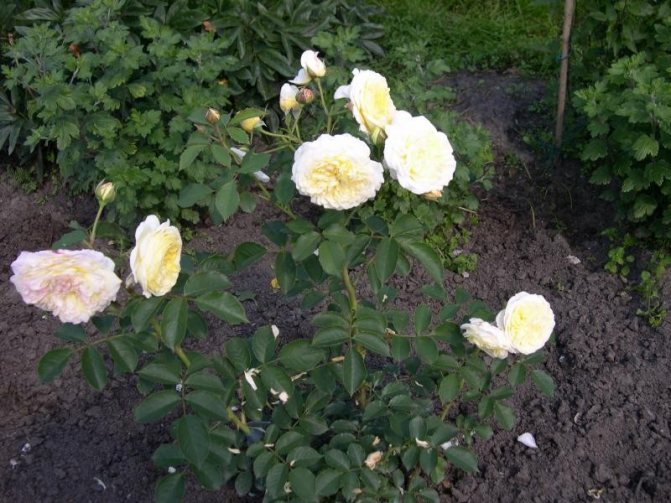

Hot weather, extreme aridity provides for an increase in its consumption - two buckets, the frequency is three times. Watering is recommended in the evening with settled water.
Advice! Shaking off the inflorescences from heavy rain, you will save them from decay.
Systematic loosening, shallow penetration. Removal of weeds in the near-trunk district is mandatory.
Tulips like peonies
How many petals do spring primroses have - 5-7? No, peony varieties have more than 20 of them! Imagine how beautiful the bouquet looks when each the bud reveals several dozen colored petals
.
The first double tulips appeared more than 4 centuries ago, but still less than 10% of the market is devoted to these flowers. The idea of the tulip as a modest, non-fluffy plant is too deeply rooted. We urge our readers to break stereotypes and enjoy peony tulips before the season of their large-doubled counterparts has yet arrived.
Now you know, what can be used to replace peonies before their season arrives.
It turns out that the choice is very large, and every month you can please your beloved with voluminous and bright compositions.
The season of peonies has begun
Discounts up to 40%!
Pruning
Ignoring this action during rooting may result in a low survival rate of the purchased specimens.
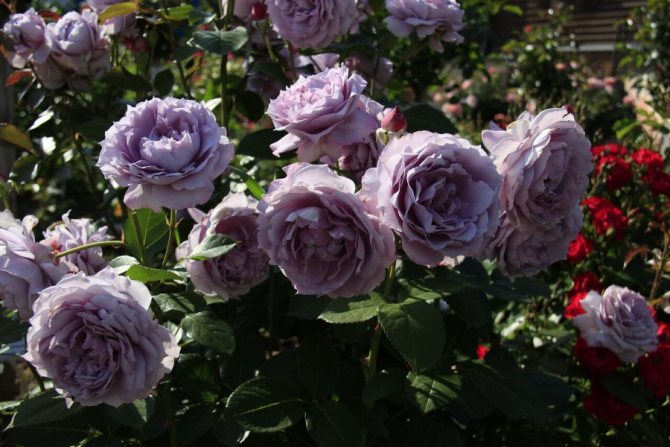

Repeated seasonal rampage is achieved by regular pruning, with particular attention being paid to the initial procedure before the leaves appear.
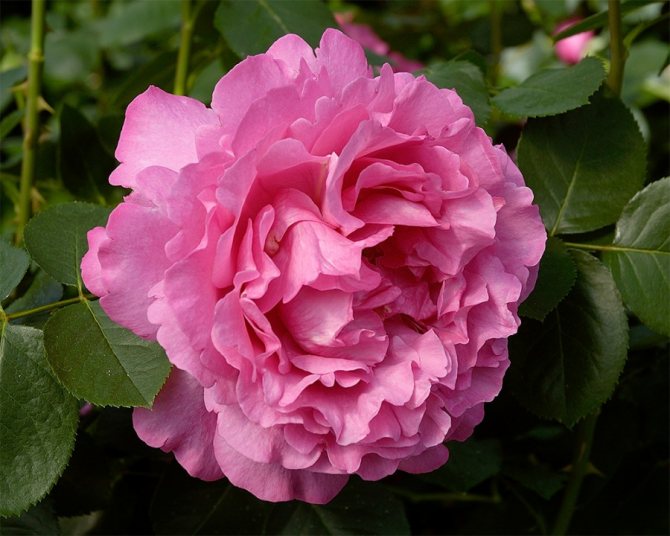

In the summer, you need to watch out for early twigs. Timely pinching of the top will allow the rudiments to open up in lush cups, the charm of the nursery will exceed all expectations.
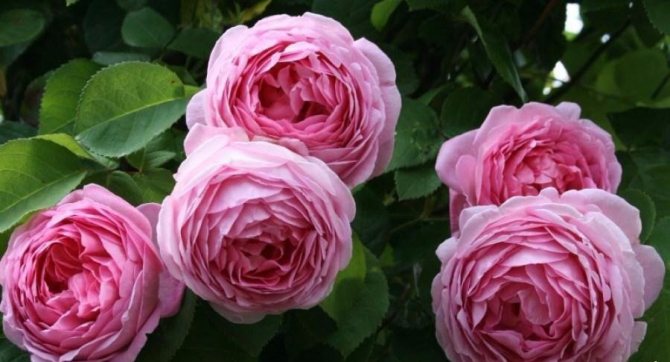

In preparation for frost, weak, damaged stems are removed. Dried leaves and remaining flowers are removed. After the cold pore, the plantings are thoroughly thinned out, no more than four shoots are left.
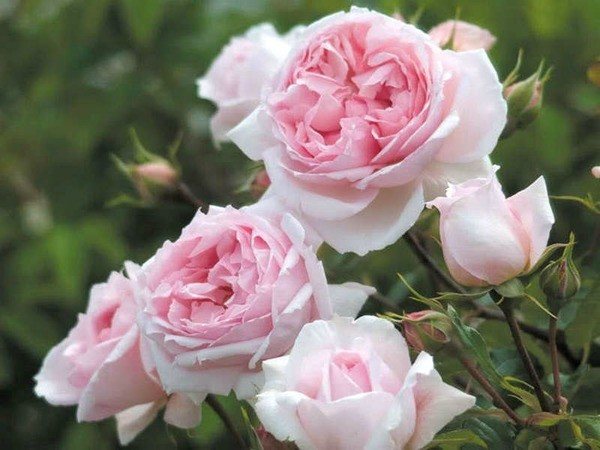

Long vines do not reserve at rest, with the onset of heat they can lose their receptacle. It is more convenient to work with well-sharpened secateurs.
Are there chrysanthemums that look like peonies
With the word "chrysanthemum", most represent bush varieties that resemble chamomile. However, the autumn flower is lush pump-shaped
... Single-headed chrysanthemums have more than a hundred identical, symmetrically located, slightly curved petals. Due to this, the inflorescence looks voluminous, but neat.
By the way, sunny yellow chrysanthemums look spectacular. Among the Peony family, only ito-hybrids have lemon shades, but they are not grown commercially.
Top dressing
An essential part of caring is the use of nutrients. It is worth noting that transplants that have reached one year of age are fertilized. Various additives are added three times over the entire season, the repeatability is four weeks.
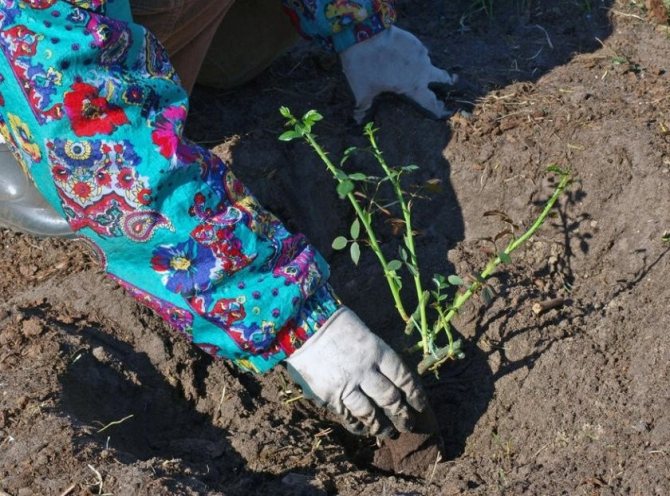

Begin feeding before the birth of flowers with preparations containing nitrogen. Further, the enrichment of the land composition provides for organic matter and complex fertilizers.
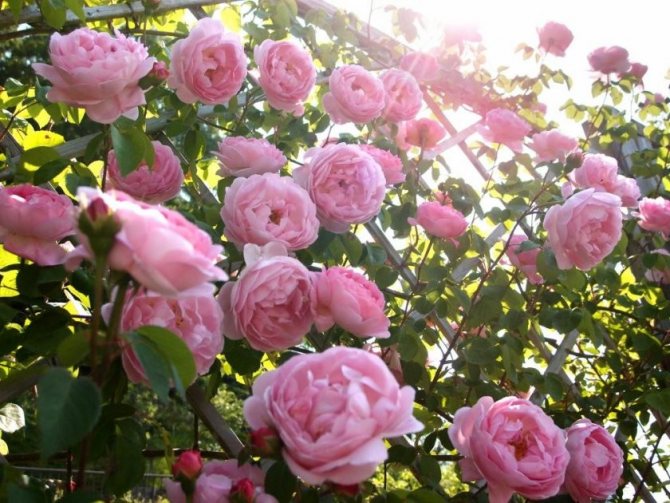

Preparing individuals for wintering, the land is fed with resources with the presence of phosphorus and potassium.
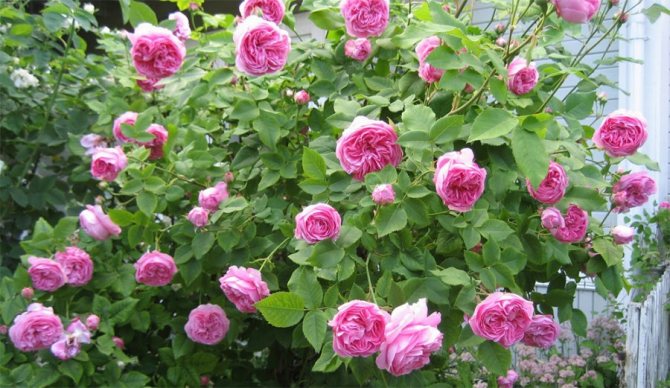

Adults also need an additional diet. What is feeding:
- rotted consistency compost;
- fermented cow dung, previously diluted;
- infused chicken droppings, used with an aqueous solution of 1:25;
- ready-made mineral mixtures;
- ash of wood;
- bone meal;
- compositions of folk recipes.
Any organic matter must be fresh. The middle of August is the time of the last feeding.
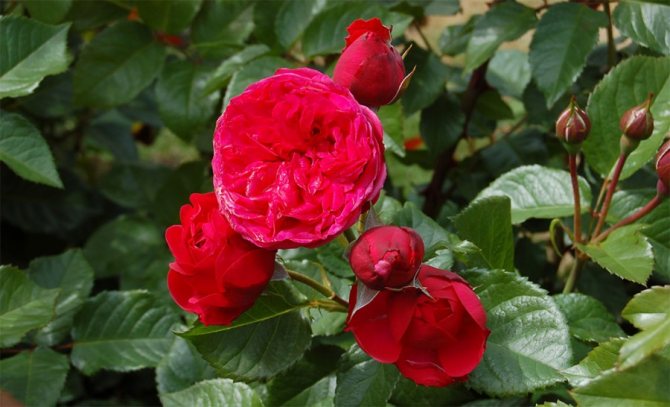

Royal roses in prefabricated bouquets
These plants are ideal for both mono-bouquets (made up of one type of flowers) and for prefabricated compositions in which several plants are combined at once. Peony roses are successfully combined with flowers such as:
- Hydrangeas. Large caps of hydrangeas in bouquets are soloists, but they need “reinforcement” with smaller and more delicate flowers. The peony roses in these compositions balance out plants of different sizes.
- Lisianthus or eustoma is a delicate plant traditionally used for wedding arrangements. Peony rose in combination with eustoma creates a delicate, harmonious bouquet. At the same time, the rose gives the bouquet a light aroma, which Lisianthus lacks.
- Rose of traditional shape. Very often in prefabricated bouquets, the peony rose complements the usual varieties of the classic form. This combination makes the composition more modern and dynamic.
- Peonies. If you collect a bouquet of peonies and Austin roses, then few people at first glance will be able to recognize that there are different plants in the composition. This is a truly refined option for connoisseurs of beauty, in which the tenderness of a rose is complemented by the luxury of peonies.
In addition to traditional bouquets, the peony rose is extremely in demand as a soloist in compositions that are often prepared for brides. There are so many reasons for this that it would be strange if this plant went unnoticed. Judge for yourself:
- Delicate aroma. Modern plant varieties rarely boast a pleasant smell. As a rule, they are neutral, that is, they do not smell. Whereas the peony rose is absolutely captivating and as beautiful as the bride!
- Refined look.Rounded buds with a lot of petals are ideal for making spherical and hemispherical wedding bouquets.
- Rich colors. Among the modern varieties, you can find plants with pale lilac, pink, cream, apricot and other traditional wedding shades. Want something brighter? You are welcome! Breeders have developed interesting cherry and purple varieties.
Preparation for wintering
Despite the frost resistance of the ostins, it is worth taking care of their safety during frosts. Acceptable material to be covered is sawdust, sand, earth cover.
Organics can be harmful. Small pits with poison will serve as protection from rodents. The stems take cover to a height of 15 cm, as high as possible.
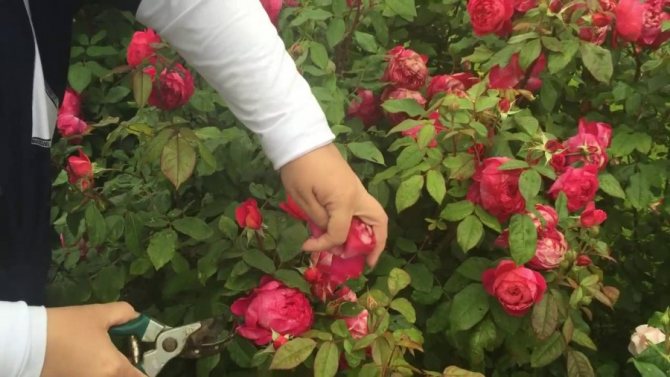

Curly rocks must be first removed from the supports, diligently laid out on the surface, then covered in any suitable way.
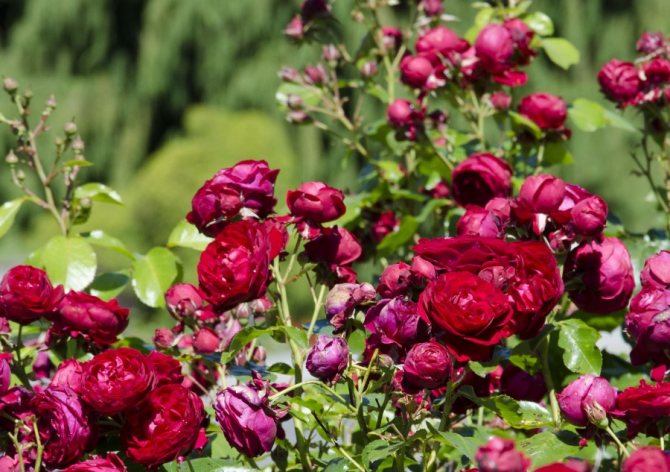

Preparatory work begins in October. Frames are often used for the convenience of storing the stems in the winter.
Peonies and ranunculus: difference and similarity
Who would have thought that the Asiatic buttercup could compete with the royal double flower. But everything is possible in floristry. Especially Dutch unopened peonies resemble ranunculus. Both plants have dense, round buds.
Blooming ranunculi are approximately 6 cm in diameter.
On the one hand, this is a little compared to 10-12 cm for peony, but they are cheaper. Buy a few dozen of them, and you get a huge armful. For a girl, this can become a truly original and unusual gift. According to the observations of the florists of the Seven-Flower, men often give the usual flowers, buttercups for them are exotic, which they underestimate.
Damage, prevention, treatment
Austins are quite resistant to a variety of diseases. However, examination for ailments is necessary.
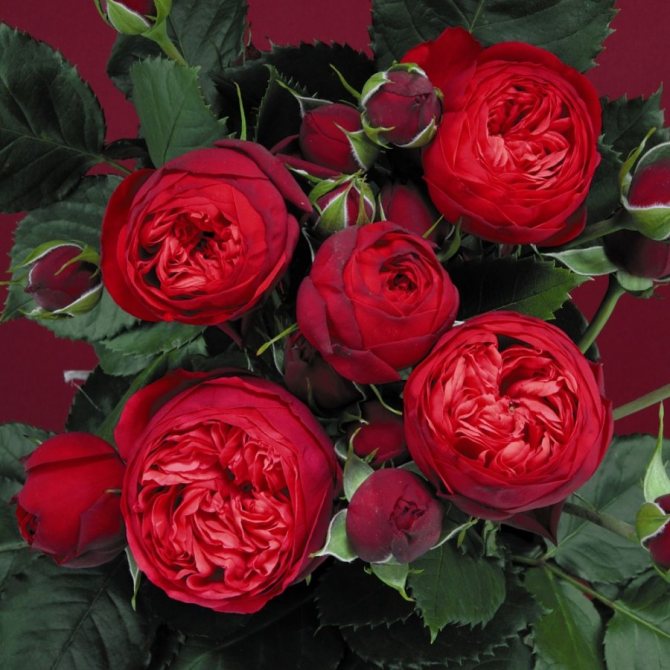

An abundance of dampness, high temperatures, direct sunlight for a long time, a lot or, conversely, little fertilizer, inadequate pruning are factors contributing to the occurrence of infectious, mushroom-like ailments.
Popular are called:
- black spot;
- rot is gray;
- the mosaic is viral;
- powdery mildew;
- rust.
Signs of damage that appear require immediate attention. In order for David's triumph to continue to delight, it is necessary to avoid dense bush thickets.
Prevent drying out of the soil cover, spraying and watering should be done only in dry weather. Having opened shoots after winter, you should not place covering devices nearby. Checking their health, you should cut out damaged, dried branches.
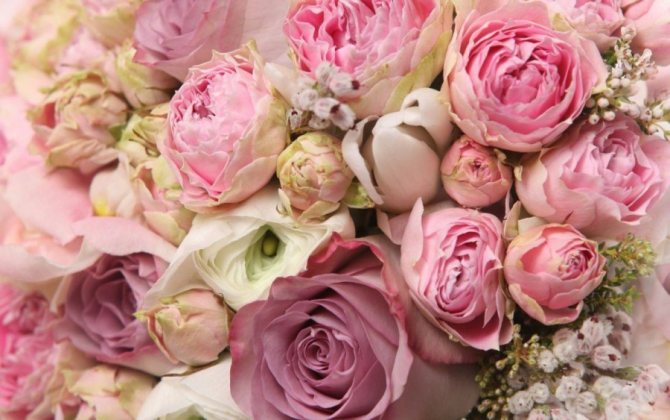

Add nitrogenous additives in limited proportions. Carrying out all preventive measures, the health of the pets is guaranteed.
If the ostins are sick, use soapy water from folk remedies, Bordeaux liquid from professional preparations. An effective, affordable, versatile panacea capable of healing sick units.
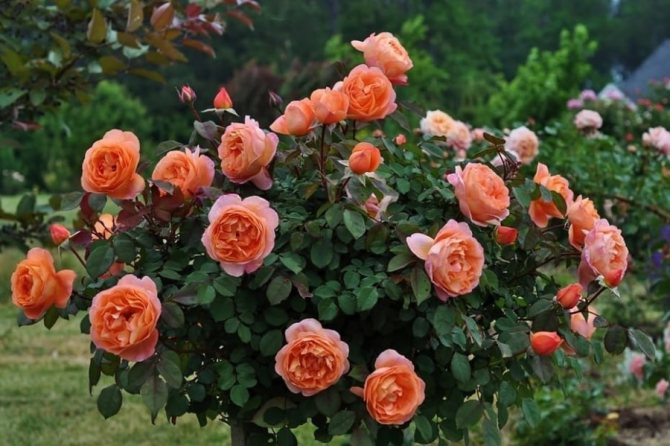

Features of planting and growing
There is nothing difficult about growing these amazing roses. The most important thing is the correct fit. If the bush is planted in the right place, in good soil, then it will grow rapidly and delight with abundant flowering with very minimal maintenance. Planting roses should be done in prepared and well-fertilized soil. Horse manure is considered the best fertilizer for this type of flowers, since it saturates the soil well with nitrogen. It is laid in a thin layer (about 2 cm) at the bottom of the planting pit. In the absence of horse manure, compost can be used.
Planting holes are dug wide (up to 1 m) and deep (at least 50 cm), since an adult bush has a voluminous root system.
Depending on the variety, rose seedlings are planted at a distance of 0.5-1 m in the form of a triangle.This scheme allows you to achieve the effect of beautiful decorative thickets, completely covered with inflorescences.
Before planting, it is recommended to place the seedlings in a growth stimulator for several hours - this procedure accelerates the rooting of the plant in a new place. When planting, it is necessary to ensure that the roots of the seedling are freely located in the planting pit. As for the planting depth, it is considered ideal to deepen the roots into the ground by 10 cm - at this depth they will not freeze.
Peony roses, like any others, prefer sunny, windless areas, but heat and sun are not vital for them. They bloom quite successfully in partial shade, in addition, in the Austin collection there are several shade-tolerant varieties that can grow even in difficult weather and climatic conditions. According to the breeder, peony roses only need 3 hours of sunshine daily for full flowering.
How to dilute Austins
Reproduction is not particularly difficult.
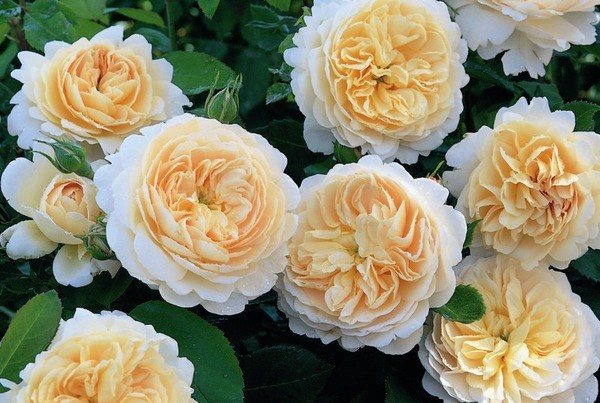

First, you need to decide on the breeding technology: cuttings, layering, seed method. Secondly, to create optimal conditions for the growth and flowering of pets.
The simplest modification is to use stems. The lower branch, originating from the base of the branch, is carefully sprinkled with any ingredient, setting aside until nature awakens.
During this time, the process takes root, it is separated from the maternal trunk, and transplanted.
Reception of the use of shanks is not difficult, subject to the recommended sequence:
- clean a healthy stem (up to 20 cm) from wilted leaves, flowers, if any;
- put in some water (you need to change it periodically), monitor the maturation of the eyes, roots;
- plant the cutting in open ground, cover with any container;
- remove the shelter from the green leaves that have appeared.
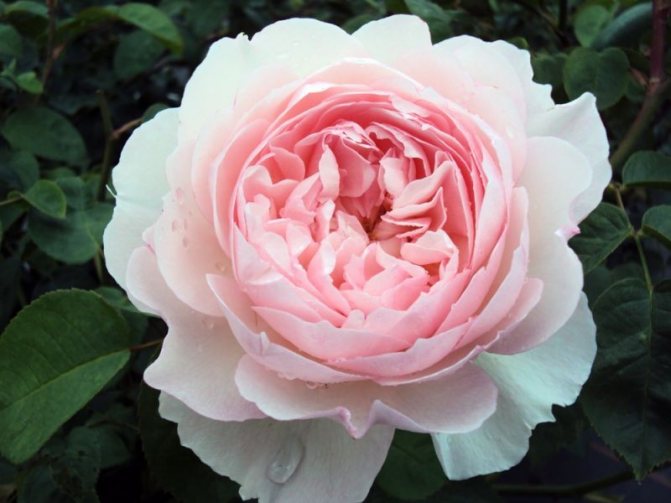

Seed propagation is considered by professionals to be the most laborious version - the duration of germination (about a month), the creation of indispensable criteria for successful planting. However, the result is worth it.
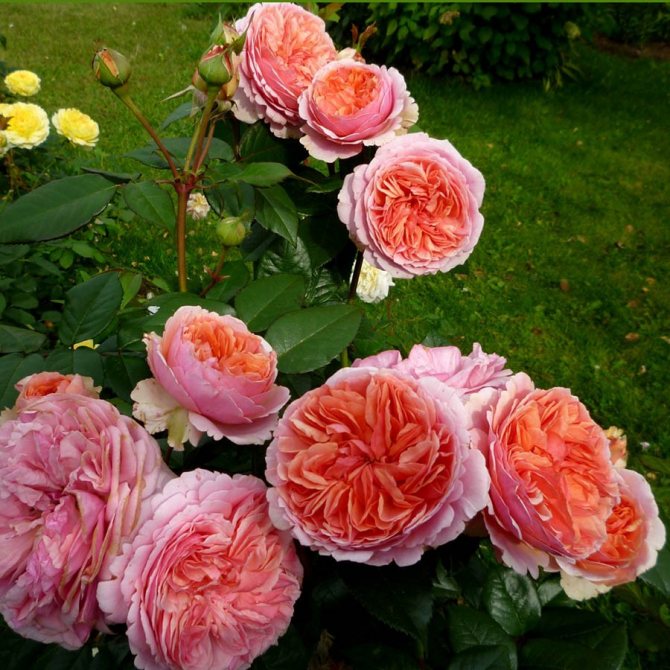

Recommendation! Strict adherence to the timing of transplantation is a guarantee of reliable survival of seedlings. We are waiting for a cold snap (+ 10 ° C and below), a stop of the juice movement, we transfer it to another space.
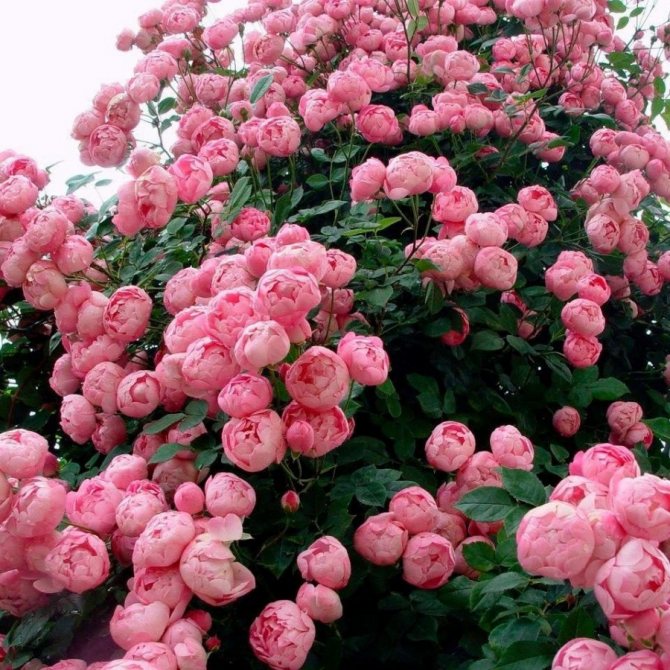

Pink hybrids
Peony roses can be of almost any shade, but pinkish hybrids are the most common. Austin roses of pink shades more than flowers of other colors, resemble peonies in their appearance. The color palette is quite extensive, the intensity of the color of the buds varies from delicate pale pink shades to rich fuchsia color.
The most famous are the following varieties.
Constance Spry
Constance Spry rose flowers are considered one of the largest among all English and antique roses. Their size reaches 15 cm in diameter. Delicate pink buds of the variety have a rounded cup-shaped shape and a pleasant chypre aroma. The texture of the petals is dense. The foliage is dense, matte, slightly harsh. The height of the bush reaches 5 m, width - 2.8 m.
Constance Spry's description says that the variety is well adapted to cold climates and tolerates shade well. The rose blooms once a year in early summer. After flowering, there is a high risk of damage by powdery mildew and black spot.
The variety is easy to cut and, when grown on its roots, forms a low, highly branched bush.
Important! Rose of this variety often falls apart when grown alone, so it is better to plant Constance Spry in the garden in small groups or as a climbing rose.
Miranda
Hybrid Miranda is a peony bush rose with a pleasant, but weakly pronounced aroma. The variety is compact, low. The height of the bush rarely exceeds 1.5 m. The average width is 50-55 cm. The flowers of the rose do not form inflorescences, so that single flowers are convenient to use when making bouquets. Miranda buds are medium in size, their diameter is 10-11 cm.The outer petals of the rose are painted in a pale pink, approaching white, while the inner ones are much more saturated in color.
Rose Miranda blooms 2 times a summer. The plant grows well in high humidity conditions and is resistant to partial shade. The compact shape of the bush allows you to grow this variety without support.
Rosalinda
The flowers of the Rosalinda variety are colored in a delicate creamy pink color. The length of flowering shoots reaches 40 cm, the inflorescences consist of 6-9 flowers, which are ovoid and have a double petal texture. The buds reach 14 cm in diameter. The aroma of the rose is poorly expressed. The foliage is small, matte.
The height of the bush reaches 80 cm.
The variety is resistant to sudden changes in temperature. Rosalind feels equally well both during the heat and during the frost. It is better to grow a hybrid outdoors.
Keira
Rose Keira is a disease-resistant variety with a lush vintage flower shape. Plant buds reach 9 cm in diameter. The color of the petals varies between pale pink and peach shades.
The aroma of the Keira variety is persistent and intense.
The average height of the bush is 60 cm.
Juliet
David Austin Juliet's peony roses are a variety with large dense buds. The flowers of the hybrid do not constitute inflorescences, therefore the Juliet rose is often used when drawing up bouquets. The diameter of the buds reaches 8-10 cm.The height of the bush is 100-110 cm, the width is 70-75 cm.
Rose Juliet stands out against the background of other varieties of Austin hybrids with a spectacular gradient, namely the smooth transition of a rich peach color to a delicate cream at the edge of the petals. The scent of Juliet rose is of medium intensity.
The variety rarely suffers from black spot and powdery mildew. Also, peony roses Juliet are resistant to rain - the flowers are rarely damaged by moisture that collects in them.
Amazing innovation
Almost fans of rose flowers all over the world adore, prefer celebrity masterpieces, especially red specimens. He can be seen everywhere - surrounding houses, decorating lawns, in various sets, single compositions.
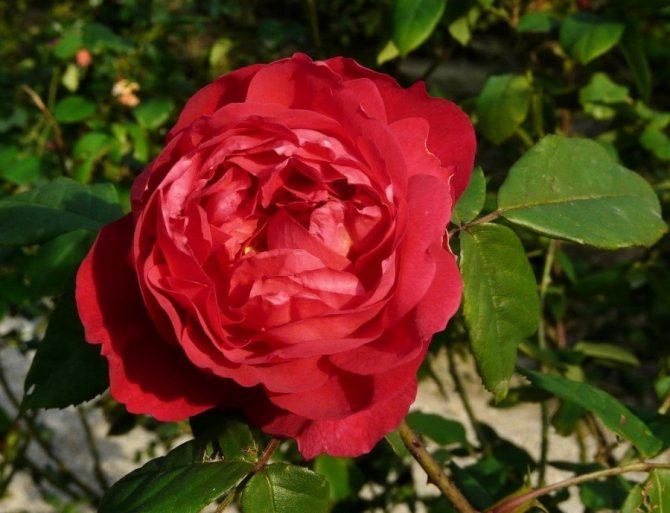

Rose peonies have an incredible variety of colors and shades, making it difficult to navigate among this splendor, despite the presence of the class name and the photographic image presented. You can distinguish them by the shape, color, volume of the petals.
The range of colors is huge - from white to burgundy with a nuance of color. A real breakthrough in the field of selection is the beautiful Pat, named after the scientist's wife, charming with copper, amber, coral, yellow tones, large balls resembling an oriental bowl.
Snow-white, changing its color three times during the flowering phase, with intense notes of myrrh, Claire vanilla was bred quite recently. The gorgeous piece owns the name of the breeder's daughter.


This article is the main component of the bride's wedding bouquet. Designers love to work with them, using a soft component - foamiran. When creating festive congratulatory structures, you should focus on properly cutting the stems.
To create a fragrant, attractive oasis for relaxation is possible only with the use of peony ostins. Proof of this is the unsurpassed photos in landscape design magazines.
The best white varieties
Peony varieties with white petals are presented in small numbers. Their description will certainly interest gardeners who want to decorate their flower beds with exquisite plants. White rose can add chic to any wedding bouquet.
- Tranquillity is a novelty in floristry, since its breeding by English breeders happened recently (2012). The diameter of the buds of Tranquility roses reaches 12 cm. The closed petals are characterized by the presence of a yellowish tint. When the corolla opens completely, it takes on a white color. The fragrance is pleasant with recognizable apple notes.
Tranquillity
- Claire-Astin. The medium-sized Claire Austin bush during flowering is covered with white roses (up to 10 cm in diameter), characterized by the presence of a cream shade. On one branch, 2 - 3 buds are formed, giving others a rich, rich aroma. The plant easily tolerates high humidity, blooms 2 times during the season.
- Alabaster. Peony double rose. The shrub is compact, reaches 90 cm in height and 50 cm in width. Tall stems are crowned with 5 - 6 buds, which bloom 2 times a year.
Photo of peony roses
Fact 3. Amazing resilience
David Austin originally tried to create a flower with persistent properties that can be used to create long-lasting bouquets. And he succeeded. The peony rose combines a long, powerful stem, large and strong bud, resistance to parasites and diseases.
In order for a bouquet of roses in Kazan to please you, you should adhere to simple rules for as long as possible:
- put the composition in settled water and a clean vase,
- flowers will like cool water,
- cut the stems with a sharp knife at an angle of 45o under running water,
- remove the lower leaves,
- Place the vase in a cool place out of direct sunlight.
Peony roses after cutting with proper care can last up to 3 weeks.
Description and photos of varieties
Constance Spray
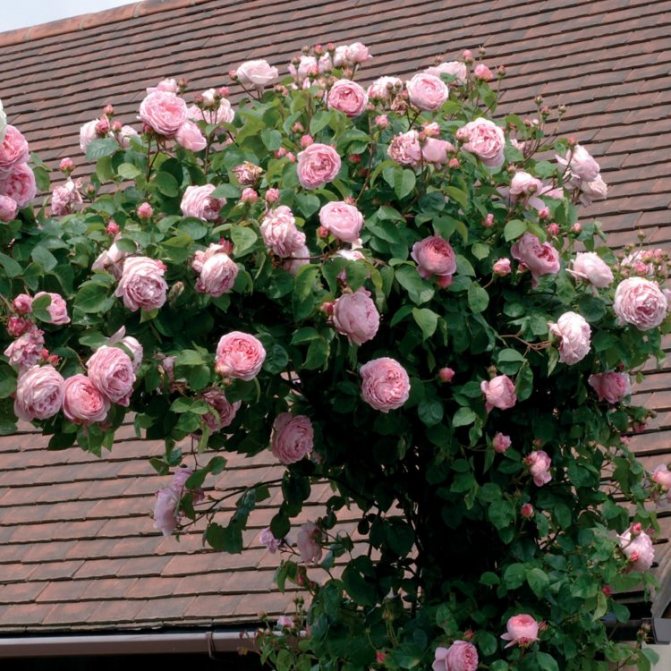

This variety was the very first one that was bred and is in great demand today. The flower has large buds of pale pink color. An adult bush, can curl on a support. Lush flowering roses, distinguished by the presence of many fragrant buds.
Read about the original curb roses of the Spray varieties here.
Juliet
This variety is distinguished by brightly saturated double flowers with a pronounced odor. A bush of short stature - 1.5-1.8 m. It is desirable to grow the variety in partial shade.
Pat Austin
The variety has bright yellow-orange flowers. They are semi-double type, large in size with a delicate aroma. The variety has a long flowering time that can last all summer.... The plant can withstand cold and shade.
Benjamin Britten
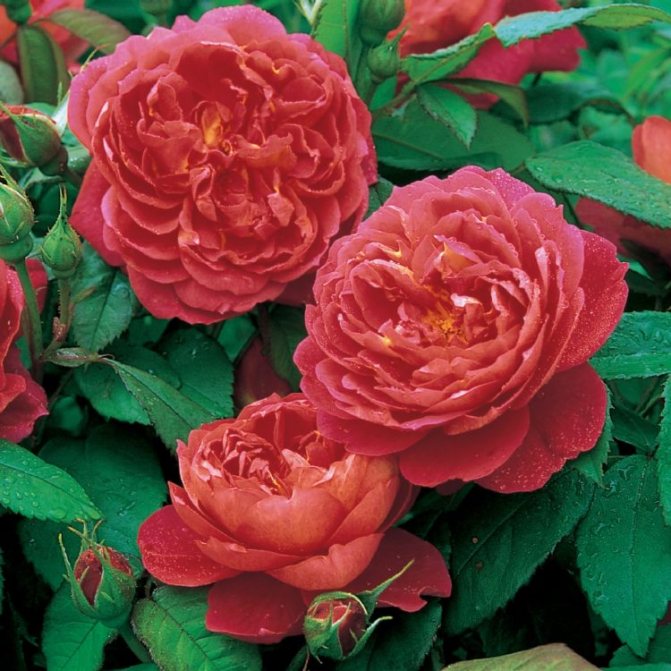

The variety has large and double buds, their diameter is 10-12 cm. The color of the flowers is bright crimson. They give off a delicate and fruity aroma. Bushes of medium height - 1.5 m. The variety resists diseases and tolerates cold well.
Misty Bubble
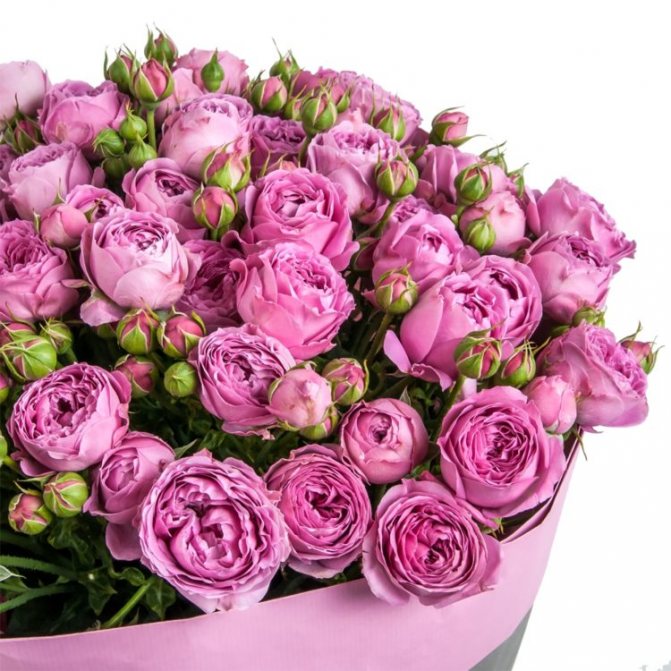

The buds of this variety have a bright purple color, the aroma resembles oriental spices. Misty Bubble blooms profusely, and up to 5 peduncles can form on one bush.
Lady charlotte
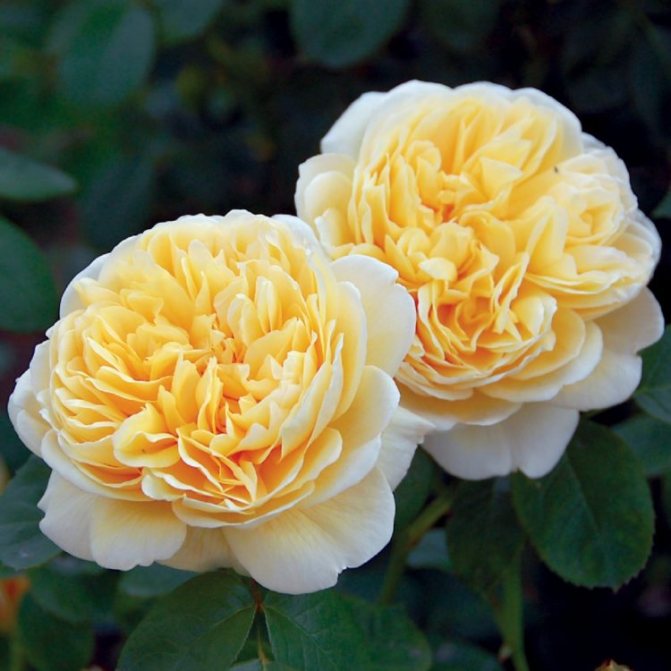

It is a young variety with a pleasant yellow color. The aroma is also delicate, but intense, reminiscent of a tea rose. Rose buds are large, double type... The flowering is undulating and long lasting.
We talked about the variety of species and varieties of roses here.
Flower care
Immediately after planting, bushes or cuttings should be watered abundantly with warm water. It is recommended to mulch the trunk circle, and then leave the plant to be taken for 1-2 weeks. When it becomes noticeable that the plant has begun to grow, you need to start taking care of it fully.


- The ground under the peonies should always be slightly moistened. Some varieties tolerate an abundance of moisture well, but this plant does not like drought. Based on this, as well as climatic conditions, the seasons select the optimal irrigation schedule.
- Mulch can reduce the amount of watering you need and also inhibit the growth of weeds. For roses, peat, crushed bark, wood shavings, fallen leaves or pine needles are suitable as mulch. You can also buy decorative stone, pebbles, coarse sand for mulching the ground.
- Top dressing is applied no earlier than 2 years after planting. Different remedies can be used depending on the time of year. In the spring, to activate growth - a complex dressing for roses, at the beginning of July - nitrogen substances, and during the formation of buds - potassium-phosphorus mixtures.
- For some varieties, support is needed for the comfortable development of the bush, otherwise the pagons, under the weight of the buds, will fall directly to the ground.
Important!
The abundance of fertilizers is also harmful to the plant, as well as their lack. If there are too many minerals in the ground, this will lead to yellowing of the buds or even the death of the entire bush.
- Pruning is done in spring and summer to form a normal bush. But there are no special rules. The flower grower can choose the shape of the bush he needs and stick to it or change it if he wants something new. But sanitary pruning is carried out annually, in the fall.
- Pests and diseases on Austin roses are very rare. This usually happens if the plants nearby are severely affected. In this case, you can use a strong insecticide or fungicide for spraying, depending on what the bush is affected by.
- Austin's rose is considered an unpretentious plant, and yet not all varieties tolerate frost. If the variety is not frost-resistant, it must be insulated for the winter. In some cases, the bush is completely covered with insulating material on top, and the root zone is mulched by 25-30 cm with opiski, foliage or peat.
Peony roses are a decoration for any area. They grow into beautiful bushes or weave, have a strong immune system, and at the same time bloom in large, lush flowers of a wide variety of colors. Today it is one of the most popular types of roses, especially given the varietal variety and unpretentious care.
Peony roses: types and varieties with photos, care and planting
Peony roses are the so-called hybrids of David Austin. They are called peony because of their lush shaggy flowers, reminiscent of blooming summer peonies.
David Austin's roses were bred in the eighties of the twentieth century by an English farmer who is fond of selection. Thirty years earlier, David Austin, having seen old roses at an exhibition in France, began to dream of creating a new variety of roses. David Austin wanted the roses to resemble old roses, but they were disease resistant, bloom again, had a tasty lasting scent and a beautiful bush shape.
At the same time, he dreamed of bringing roses of various colors, because the old roses of France, for all their beauty, were of a fairly ordinary color. There were no yellow, orange, lilac-pink among them.
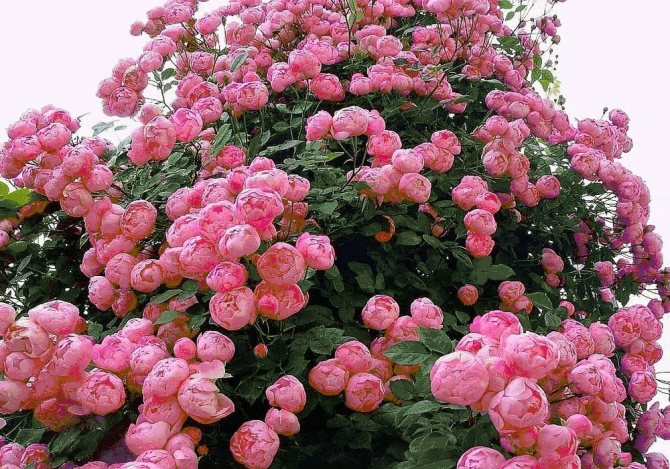

When David Austin crossed one of the Gallic roses with a modern floribunda, the result surpassed all expectations - the seedlings turned into strong, proportional shrubs with large flowers of an interesting shape. It was David Austin's first peony rose.
Now such roses are popular all over the world, including among Russian gardeners. Roses of David Austin are famous for the beauty of flowers, decorativeness, adaptability to not the best climatic conditions, resistance to infections. At the same time, peony roses have a wide variety of colors. David Austin's dream has come true.
Few flowers are so loved and revered by gardeners in all countries. Peony roses can be seen in flower beds, in front gardens, on lawns, in bouquets and in single compositions. These roses are especially advantageous for their resistance to our unpredictable climate, as well as to pests and diseases. The fact that such roses do not require very difficult maintenance makes them even more attractive.
Use in landscape design
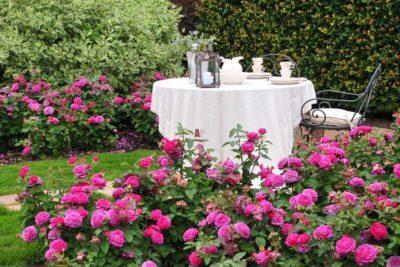

The peony rose is used to create a tall hedge... Bushy varieties of compact size will be an excellent addition to a flower garden or mixborder.
English roses are suitable for planting in groups of low-growing shrubs to create a background. Views such as Mortimer Sackler and The Pilgrim are featured in pergolas and gazebos.
Also, peony roses can be planted in pots or containers, used for landscaping.
Features of pruning rose bushes
Pruning the bush should be done before bud break, removing weak and old shoots.In this case, the branches must be cut by a third. Depending on the imagination of the grower, the bush can be given a non-standard shape. In October, you need to cut off ripe shoots and leaves. When growing roses in a curb version, they must be pruned to an approximate height of 0.6 meters. The first wave of flowering will take place at the same level, the second and subsequent ones - at different levels, because young shoots will begin to grow actively, exceed the specified height, thereby violating the desired harmony.
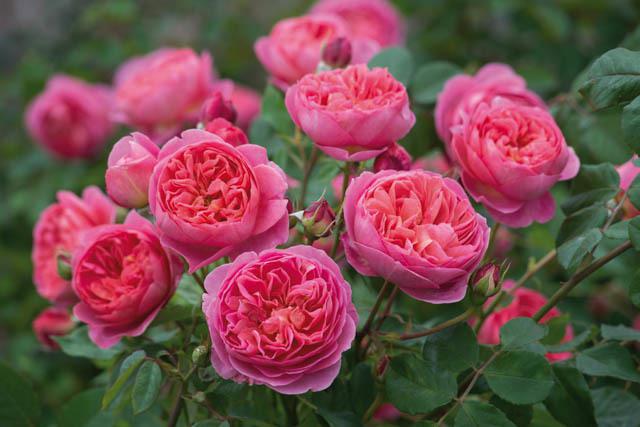

Pre-winter preparation includes bending the stems to the ground, then fixing them, covering them with soil, sawdust or foliage. Straw can be placed on top to keep warm. It is not recommended to use the film as a covering material due to the lack of air access.
Breeding methods
The main methods of growing roses are 2 simple ways:
- Cuttings. They choose a ripe, woody branch of this year. A full-fledged cutting is a segment on which there are 3 branches. The lower sheets are removed, and the upper one is left. When landing, only the top leaf is left on the surface. From above, the cutting is covered with a jar or cut plastic bottle, thereby creating a greenhouse.
- Creation of a branch. The area where the diversion will be fixed is cleared of weeds and dug up. Choose one branch and cut along the bottom. Tilt to the ground and secure with metal staples. Sprinkle with earth and watered. The end of the branch is tied to a peg.
Growing a peony rose
To successfully grow a peony rose, you need to find a suitable place.
- Illumination should be moderate. Austin roses can be grown in partial shade, but not in full sun. 3 hours of sunshine a day is enough for this species, but without sunlight at all, it will not give flowers.
- The soil is loose, nutritious and well-drained.
- If necessary, the acidity of the soil decreases, because the acidic environment is not suitable for this culture.
- The groundwater level should be low.
Before planting, fertilizers are applied to the ground, most often horse humus, because it is best absorbed by plants. Plain compost can also be an alternative. To plant a small bush, you need to make a hole 50 cm deep and a meter wide. Drainage is placed at the bottom, and a pile of fertile soil is placed on top.
Important!
Austin roses can be planted exclusively in well-fertilized soil. If the soil is poor and lacking in nutrients, the plant will take a very long time to root, if at all!
The bush is placed on a hill made of earth and its roots are well spread. The pit is gradually covered with earth so that the depth of immersion of the rose is within 10 cm, this can save it from severe winter frosts. Plants near peony roses can be planted only at a distance of half a meter or even a meter, for those varieties that are splendid.
Peony garden rose Alabaster (Alabaster rosa) photo
This variety was bred in 2007. The size of the flower is usually 7-10 cm, the color is creamy white. In addition to the large flower, this rose has a very pleasant aroma. After delivery from the flower base, the flower needs time to open, as a rule it is 3-4 days!
Roses by David Austin: from history to modern times
Dense double roses were bred by the efforts of breeder David Austin in the 60s of the last century. The Englishman managed to create flowers that in appearance very much resembled the old types of garden roses, but at the same time were famous for their resistance to disease. The result of the fruits was new varieties with excellent decorative qualities, which were able to please with multiple flowering, accompanied by a stable pleasant aroma.
The ancient roses of France became the prototype for the creation of peony varieties. For all their beauty, their significant drawback was the faded shades of the buds. The breeder managed to develop varieties of spectacular yellow, orange and lilac-pink shades.
Today, bush peony roses, although they include a large number of varieties, are not bred into a separate class. In popular literature, they are more often found under the name "English". Varieties differ in color, size and flower shape, as well as cut resistance and aroma.
In the kingdom of royal flowers, peony roses, captivating with their vintage beauty, are practically unmatched. They are revered by gardeners from all over the world. Compact bushes with lush buds can be found both in the design of suburban areas and in the cityscape. They decorate plant compositions and cut bouquets. Climbing varieties can form low claimings with well leafy stems, over the entire surface of which buds are evenly distributed.
Hybrids of noble white
There are over a hundred shades of white in nature. Austin's varietal hybrids exhibit them perfectly. In the collection you can find both varieties of peony roses, the color of the petals of which is whiter than freshly fallen snow, and bushes with buds, glowing in the sun with a light mother of pearl or turning into pink over time.
The most decorative varieties are famous:
- "Claire Ostin" - a variety, bred in 2007, forms large buds, which can include up to 40 petals of a creamy white hue. It is presented in two versions - bush and curly.
- "Glamis Castle" is a dense double variety that forms buds with up to 120 petals. The tops of the branches covered with thorns are decorated with flowers up to 10 cm in diameter. The delicate and fragile branches of the plant need support.
- "Fracine Austin" - climbing plant produces branches up to 2 meters long. Each brush can contain up to 30 snow-white flowers, spreading a pleasant aroma with hints of musk.
- "Lichfield Angel" - rose bushes up to 1.2 meters high with elongated graceful branches. Flower buds of a white-cream shade, collected in 3 pieces, in blooming form reach a diameter of 10 cm.
Widespread in landscape design are also varieties "Swan" with densely double snow-white flowers that spread a light fruity aroma in the district, and "Tranguility" with perfect-shaped flowers with a yellowish tint. The variety "William and Catherine", named by its creator in honor of the marriage of the heir to the throne, is also incredibly beautiful. Its flowers have a complex structure: the center is formed from a dozen small petals, and the surrounding crown is from large ones.
Best yellow Austin varieties
Yellow peony roses have an amazing ability to create a soft velvet effect with the play of light and shadow. Literally before our eyes, the pale yellow shade of the petals is gaining honey notes or turns into almost white. Color variability is explained by the fact that the yellow pigment is always responsible for the appearance of not only the characteristic yellow, but also the orange hue. In addition, the relatively unstable pigment easily fade in the sun, giving the petals creamy and white shades.
The list of the best varieties of Austin includes the following peony yellow roses:
- "Graham Tomas" - the variety has large flowers up to 10 cm in diameter. The blossoming buds can have up to 70 petals. Strongly branching shoots under the weight of lush buds often bend to the ground, and therefore need additional support. The bushes bloom without interruption all summer.
- "Golden Gelebration" - the variety forms especially large buds up to 16 cm in diameter with honey-yellow petals. Inflorescences are arranged in groups of 3-5 and bloom almost simultaneously. Bushes with long arcuate branches can reach heights of about 1.2 meters.
- "Toulouse Lauterc" - a variety, bred in 1993, has amazing lemon-colored double flowers. Opened cup-shaped buds consist of several dozen curved small petals.The bush is vigorous and branched, reaching a height of about 1.4 meters.
All of these varieties have a common drawback - low resistance to black spot. Therefore, they need regular preventive treatment with special drugs.
Pink peony
The color palette of pink shades of bush peony roses is very wide. Here you can find buds with pale pink petals, peach-colored flowers or even roses with a rich fuchsia color.
The classic varieties of peony roses are:
- "Constance Spry" - a variety bred in 1961, inherent in large cupped buds. To match the densely double flowers, collected in inflorescences of 5-6 pieces, a strong spreading bush is decorated with thick large leaves of a rich green hue. The cultivar has only one color per season in the first half of summer and has low resistance to black spot.
- "Miranda" is a variety bred in 2005 that visually resembles Constance Spryce. The only difference is in the size of the flowers, the diameter of which does not exceed 12 cm, and the unique color scheme. Miranda's petals are bicolor. The inside has a deep, hot pink hue, while the outside is creamy white. The grade is remontant. Re-flowering can last until the end of October.
- "Rozalinda" - a variety, bred in 1999, is distinguished by dense double buds with a diameter of about 14 cm. During the flowering period, it spreads a very pleasant fruity aroma in the area. The bushes of the plant are medium-sized. They are compact.
All of these varieties are united by the fact that they practically do not fade in the sun. Thanks to this, the beauty of double flowers with spectacular transitions from pale pink to raspberry and purple is preserved throughout the season.
Royal red varieties
Red roses are an irreplaceable classic, which look equally impressive both in the form of cut bouquets and as an addition to flower beds. They perfectly present themselves in sunny areas and partial shade.
Breeders include among the most beautiful peony roses:
- "Falstaff" - the flowers of the variety have a spectacular garnet-red color. With a relatively compact size of a bush of 1.5x1.5 meters, the plant forms numerous large buds that bloom from the first days of June to October.
- Willam Shakespeare is a variety created in 1987 by crossing hybrid tea with floribunda. From his ancestors, he inherited the richness of the hue, the duration of flowering and the persistent aroma of a spherical flower.
- Benjamin Britten is unique in that it forms dense buds that hardly open throughout the season. At the same time, the size of flowers with brick-red petals can reach 10-12 cm in girth. During the flowering period, it spreads an aroma, including pleasant wine notes. Vigorous shrubs of the plant can reach a height of 1.4 meters.
- "Otello" - a variety, bred in 1986, has densely double flowers of crimson-red color, spreading a rich aroma in a radius of several meters. The first flowers on the bush bloom in early June, the last ones complete the cycle in the second half of autumn.
Burgundy peony roses have a special charm. Just look at Munstead Wood! Thin branches of the shrub are crowned with dark red velvet flowers, reaching a diameter of 9-10 cm during full disclosure. Cup-shaped buds have a classic floral aroma, which contains notes of plum, blueberry and blackberry. Not inferior in beauty to "LD Braithwaite". Large double flowers of a crimson-burgundy plant are collected in cup-shaped rosettes. During the growing season, they spread a pleasant aroma inherent in classic old roses.
Garden rose Pink O'Hara
Very fragrant, gorgeous peony rose ... Large bud, unusually strong aroma! Available all year round.
Possible growing difficulties
With the proper organization of the care of roses, there should not be any problems with them, however, the possibility of the development of diseases or damage by pests cannot be completely ruled out.
Among the most common problems of this kind, one can single out the appearance of powdery mildew, black spot or root rot on the rose, in addition to which sometimes one has to deal with aphids or scale insects. In the first case, three times spraying the bushes with fungicidal compounds (for example, Bordeaux mixture, colloidal sulfur, "Fitosporin", "Skor" or "Oxyhom") will help to solve the problem, and in the second, you will have to use systemic insecticides like "Fitoverm", "Aktara" or " Lightning ".
Important! You can not treat roses with the same drugs for a long time, since they are all addictive, therefore, rid the flower of pests or diseases
will be more difficult.
In cool weather, with an increase in the likelihood of developing fungal ailments, for preventive purposes, the bushes are treated with copper-containing preparations.
Peony garden rose O'Hara (Latin Rosa 'O'Hara) photo
The first thing I want to say about her is the aroma ... the aroma of France, which is felt from a distance. A large bud, which needs time to open, about 3-4 days. When it opens, 3-4 hearts are formed in the center. It is grown on flower plantations in Kenya, Colombia and Ecuador. The difference: Kenya has a smaller bud than Colombia and Ecuador and is therefore cheaper in price. Available all year round and is a worthy replacement for everyone's favorite Austin at a more attractive price and much better quality!
Disease prevention
Despite the outstanding appearance, Ostinka roses do not differ in strong immunity. Under favorable growing conditions, this quality does not greatly interfere with enjoying the magnificent buds, but in the harsh realities of life, the bushes can die in a matter of weeks.
To prevent characteristic diseases, preventive and therapeutic spraying is performed. You can use a weak solution of copper sulfate, milk whey and dusting with wood ash. At the same time, when you find the first signs of black spot or powdery mildew, it is best to buy a special chemical preparation, because the rate of spread of this "infection" is very high.
In total, it is desirable to carry out three preventive measures during the season. The first spraying is carried out in late April - early May, when the first leaves appear. The second time the bushes are treated before the start of mass flowering. The third treatment is more dependent on weather conditions. The development of fungal diseases most often occurs in the second half of summer with prolonged rains and cold snaps at night.
You may be interested in: Ground cover roses: preparing a reliable shelter for the winter
For the procedure, it is best to choose a cloudy day, but no precipitation. For normal absorption of substances into the leaves, five to six hours are enough, therefore, if the rain passes earlier, the procedure must be repeated.
Flower characteristic
The peony rose is actually called the Austin rose. Of course, in honor of its creator. David Austin, a breeder from England, created a new group of roses, which had the external qualities of old roses, but at the same time sparkled with a variety of shades.
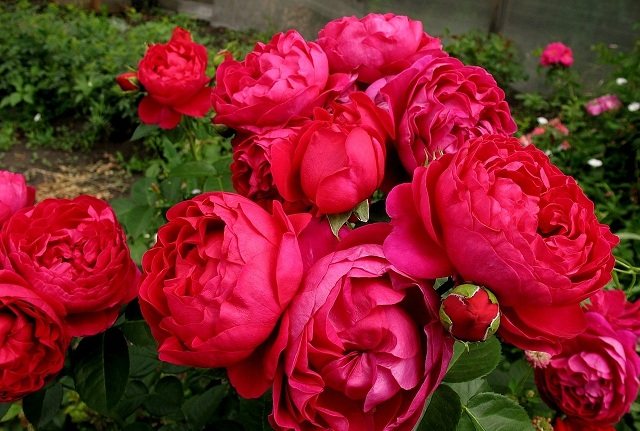

The new roses were distinguished not only by their excellent external qualities, but also by their resistance to various diseases and climatic conditions.
Needless to say, Austin's bush peony roses immediately fell in love with all growers. And many are delighted with climbing peony roses. Who can resist such lush, elegant flowers, tightly stuffed with petals, and even exuding a wonderful aroma.
English roses, as they are also called, are represented by a large number of varieties, and today there are about 200 varieties.
Reproduction of roses
Ostinki can be propagated in the same way as all other groups of roses:
- cuttings;
- layering;
- vaccination.
Cuttings
The best time for grafting is August. For these purposes, ripe, but not yet lignified branches are cut from the bushes and cuttings with three pairs of leaves are cut from them. Before planting, the bottom two pairs are removed.
Next, prepare a place for planting cuttings. For these purposes, a shady place is suitable, under trees or bushes of other plants. The site intended for planting is dug up and humus is introduced there. The cuttings are planted at a distance of 20 cm from each other and covered with cut plastic bottles, from the neck of which the cork is previously unscrewed.
The plot with cuttings is watered and left until the onset of winter. In the spring they will start to grow and begin to build up shoots. After that, they can be planted or left for further growing for another year.
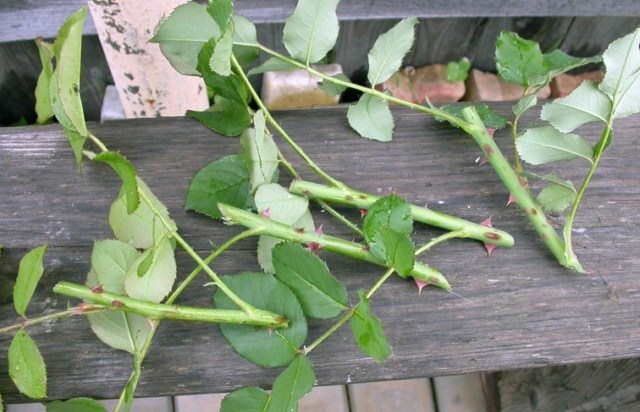

Reproduction by layering
Reproduction of roses by layering begins in the second half of summer. To do this, choose long and healthy shoots, on the lower part of which there is a cut. After that, they are fixed on the surface of the soil with the help of a wooden hairpin and sprinkled with earth. Usually, by the spring of next year, an adult plant with its own root system grows from the cut, which can already be deposited.
Graft
This breeding method is widespread enough, but it is rather difficult to use it without special skills. It requires high precision and must be done very carefully.
To carry out the vaccination, a T-shaped incision is made on the branch, into which a peephole with a bud from the desired rose variety is inserted. A properly implanted bud is immediately able to feed from the mother plant. This method of propagation is most often used in specialized rose-growing farms, where it is carried out by specially trained employees.
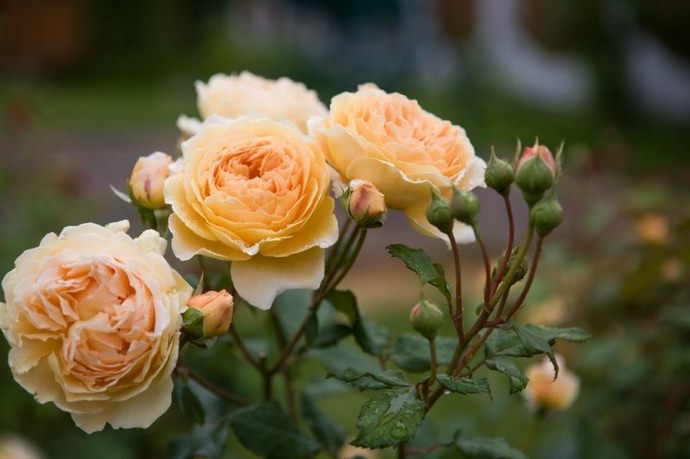

How to care for a rose for lush bloom
David Austin's peony roses are not demanding to care for. The seedlings are regularly loosened, trying not to damage the root system, weeds are pulled out and, if necessary, tied up. During flowering, plants spend a lot of energy, so they need feeding, pruning and shelter for the winter.
Top dressing and watering
Water the rose bushes as needed, based on weather conditions.
Important! When pouring water into the watering can for irrigating the rose garden, it should be borne in mind that it is better not to add peony roses than to pour. Waterlogging is fraught with root decay and the development of fungal diseases.
In the first year after planting, young plants are not fertilized. They have enough nutrients laid in the planting hole. In the second year, with the onset of spring, rose bushes are fertilized every month. The following mixtures are used as dressings:
- well decomposed cow or horse manure;
- rotted compost;
- chicken droppings diluted in water in the proportion of one glass per bucket and infused for 2-3 days;
- wood ash;
- infusion of weeds;
- ready-made fertilizers for roses.
At the beginning of the season, nitrogen should prevail in the composition of dressings, since at first the plants are gaining green mass. Before flowering, the proportion of nitrogen is reduced, replacing it with phosphorus and potassium. Throughout the growing season, the regular supply of trace elements to the soil is monitored. Wood ash, herbal infusions, and bone meal contain a large number of them. At the beginning of flowering, the bushes are sprayed with a solution of boric acid. For its preparation, 1 gram of the drug is dissolved in 1 liter of water and stirred. Boron stimulates bud formation.
In mid-August, feeding is stopped so that the plants stop the growth of the aerial part and grow roots. Before the onset of frost, the shoots should be well lignified so as not to freeze.
Shelter roses for the winter
But even lignified shoots can freeze slightly during the winter, so before the onset of the cold period, the bushes must be covered. This must be done just before the frost, when the temperature ranges from 0 to -5 ° C. If you rush and cover the roses ahead of time, they can wither away.
The shelter is made of strong wooden or plastic arcs, on which dense agrofibre is thrown and fixed. In specialized stores, covers for wintering roses are on sale. These shelters are easy to install and remove, and can be used for many years. Low bushes are covered with a layer of spruce branches, sawdust or dry leaf litter.
When in spring the temperature is firmly fixed at zero marks, the shelters are removed, the mulch is removed from the roots and trunk.
Pruning as a guarantee of abundant flowering
Pruning should be given sufficient attention, since an overly thickened bush often suffers from fungal infections and blooms worse.
Important! In the first summer after planting, all buds are removed on the shoots. Flowering greatly depletes young plants, and subsequently they winter worse and can freeze out.
In subsequent years, peony roses are pruned twice a year - in the spring they carry out sanitary pruning, and in the fall, the weak, unnecessary, broken or sick ones are pruned. The rules for pruning an English rose have important nuances:
- before trimming, the tool is sharpened and disinfected;
- one-year growth is shortened by about a third of the length;
- all shoots below the graft are excised immediately.
Also pluck out all faded and unblown inflorescences. This procedure stimulates the formation of new buds.
Disease prevention and treatment methods
Proper care of a gentle Englishwoman minimizes, but does not exclude the possibility of disease, the most common of which are powdery mildew, black spot and root rot. To prevent diseases during the growing season, rose bushes are sprayed with fungicides three times, changing them. For treatments, such preparations as Bordeaux liquid, colloidal sulfur, phytosporin, Skor, Oksikhom, Baktofit, Abiga-Peak are suitable.
In warm, dry weather, biological products can be dispensed with, in cool and damp weather, when fungal spores are activated, copper-containing ones are used.
Watering and feeding
Top dressing of peony roses is required in the spring; in June, the flowers need to be fed with nitrogen fertilizers. During the budding period, the soil should be enriched with calcium-phosphorus fertilizers. It is recommended to stop feeding the plant at the end of August. The proportions must be observed strictly according to the norm, otherwise the oversaturation with fertilizers will negatively affect the plant: the leaves will begin to turn yellow and fall off.
It is recommended to water the flowers in the evening as the soil dries up, in which case the moisture does not evaporate. Water consumption per bush is approximately 12-15 liters.
Differences from other groups
At the moment, English roses are not singled out in a separate group, according to the international classification, they should be classified as scrubs, that is, shrub roses. They are distinguished from other varieties and types by the following characteristics:
- rosette or cupped inflorescence.
- a very strong aroma that has the ability to intensify in cloudy weather.
- fast growth rates, in a short time they are able to form real thickets.
- ostinok stock never gives wild growth.
Also, peony roses are very rarely damaged by pests and have high disease resistance.
Terms and technology of planting roses
The best time for planting seedlings of this variety of roses will be mid-spring, when the soil temperature in the selected place reaches + 8 ... + 10 ° C. In the northern parts of Russia, which are characterized by lingering and wet springs, it is advisable to carry out planting not earlier than mid-May or early June.
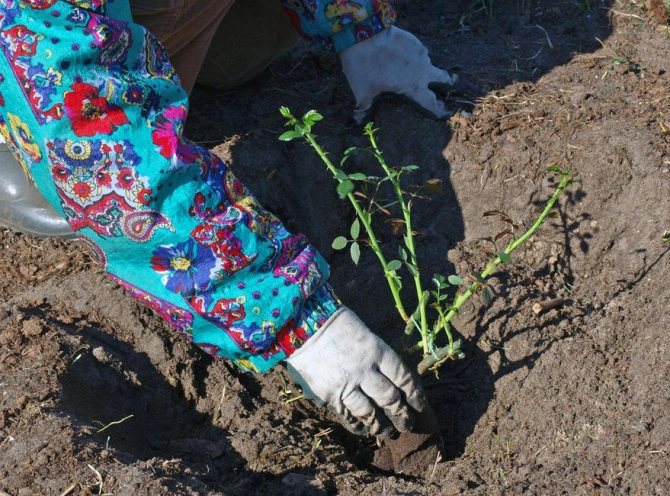

Before proceeding to planting the acquired seedling, it is worth knowing about the rules for its preparation.To strengthen the root system, it is necessary to keep the plant in warm water with the addition of a growth stimulant for at least a day. While the seedling is being processed, it's time to start preparing the planting pit, the size of which should be slightly larger than the size of the rose rhizome. At the bottom of the hole, it is advisable to lay small crushed stone, expanded clay, broken brick or any other material that can serve as drainage.
When planting on top of the drainage layer, you need to sprinkle the soil with a slide with the addition of complex fertilizers, and place the seedling on top, carefully straightening its roots. The grafting site should protrude about 8-10 cm above the ground surface (the propagation of roses by grafting will be discussed below).
Park roses are also popular among gardeners.
It is better to fill the hole with the plant in small portions of the substrate, slightly compacting each layer. At the end of the procedure, the planted rose must be watered and the surface of the soil covered with a layer of sawdust or straw, which will prevent excessive evaporation of moisture.
How to plant ranunculus
Garden ranunculus grows well in bright sun, but still prefers partial shade more. The soil should be neutral in composition, light and fertile (loam will not work). The plant will need good drainage, so add some sand to the bottom of the hole. Do not forget to add compost and pickle the soil with a foundationol solution (1 g per 1 liter of water).
Ranunculus seeds are sown on seedlings in mid-February, spreading them on the surface of light fertile soil and sprinkling with soil with a layer of 1-2 cm.Then the container is covered with foil or glass and placed in a well-lit place at a temperature of 15-17 ° C. 2-3 weeks after the emergence of seedlings, the shelter is removed, and after the appearance of two true leaves, the seedlings dive into separate pots and planted in the ground.
Before planting, the tubers are soaked in water for 3-4 hours
Ranunculus care tips:
- the plant needs regular, but moderate watering so that the roots do not suffer from excessive moisture, but also do not rot;
- remove faded inflorescences in time so that they do not interfere with the growth of new ones;
- periodically loosen the soil and apply potash fertilizers (40-50 g per 1 sq. m) once every two weeks during the flowering period;
- for the prevention of diseases, spray the plants with a 0.2% solution of mercaptophos 2-3 times a week;
- Dig up the flower tubers in the fall and store in sawdust in the winter - the plant does not tolerate cold weather and dies.
So, today we got acquainted with three peony-like flowers that are just as unpretentious in care and almost do not need feeding. And which twin brothers of peonies do you plant on your site?
Lush shaggy rosebuds, outwardly reminiscent of blossoming peonies, leave few people indifferent. It is not surprising that in the kingdom of noble royal flowers, the so-called hybrids of David Austin occupy a separate honorable niche. What types the peony rose is divided into and what varieties are most popular, we will consider in the article.
Common varieties
About 200 varieties of these roses have already been registered. But even the most winter-hardy of them require additional shelter for the winter. The table shows varieties that can be successfully grown in central Russia.
| Name | Inflorescence shape | Coloring flowers | Bush height, m | Advantages of the variety |
| Abraham Derby | Cupped | Apricot | 1,0 | High disease resistance |
| Gleis Castle | Cupped | White with a cream shade | 0.6 | Double flowers |
| Benjamin Britten | Cup-shaped, rosette after opening | Red-orange | Up to 1.0 | Unpretentiousness |
| William Shakespeare | Cupped | Burgundy | Up to 1.0 | Increased disease resistance |
| Graham Thomas | Classic | Yellow | Up to 1.0 | Long and abundant flowering |
| Charlotte | Cupped | Pale yellow | Up to 1.5 | High winter hardiness |
| Gertrude Jekyll | Cupped | Pink | 1.2 | Long and abundant flowering |
| William Morris | Outlet | Peach pink | Up to 1.5 | Powdery mildew resistant |
All the varieties presented above are perfectly combined with each other and will look harmonious even within the same area.


